Financial Accounting: Transactions, Bookkeeping, Journal Entries, Financial Reports, Principles
VerifiedAdded on 2022/11/25
|25
|4870
|184
AI Summary
This document provides an overview of financial accounting, including business transactions, single and double entry bookkeeping, journal entries, financial reports, and principles of accounting. It covers topics such as types of business transactions, trail balance, journal entries, ledger accounts, difference between financial reports and statements, and principles of accounting. The document is relevant for students studying financial accounting in various courses and programs.
Contribute Materials
Your contribution can guide someone’s learning journey. Share your
documents today.
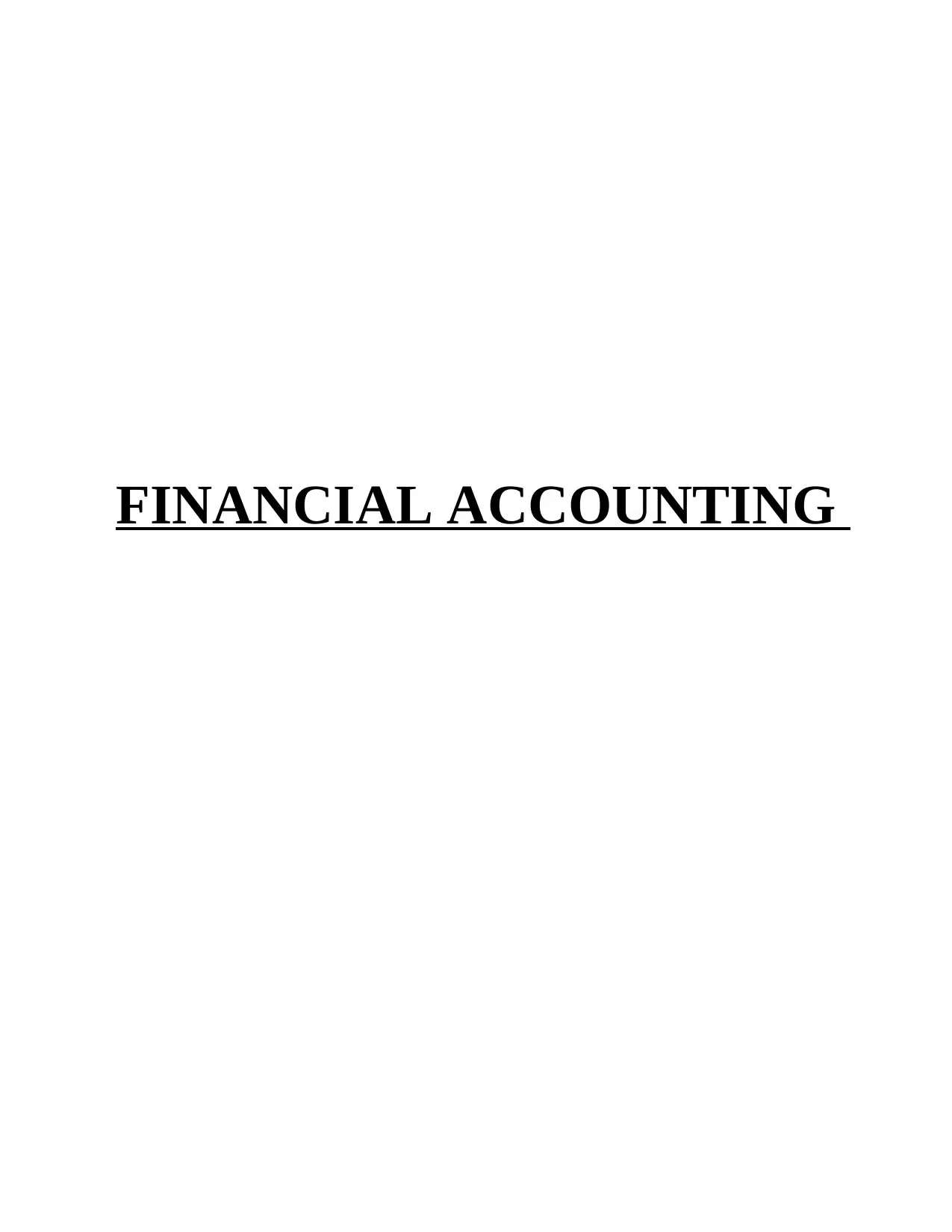
FINANCIAL ACCOUNTING
Secure Best Marks with AI Grader
Need help grading? Try our AI Grader for instant feedback on your assignments.
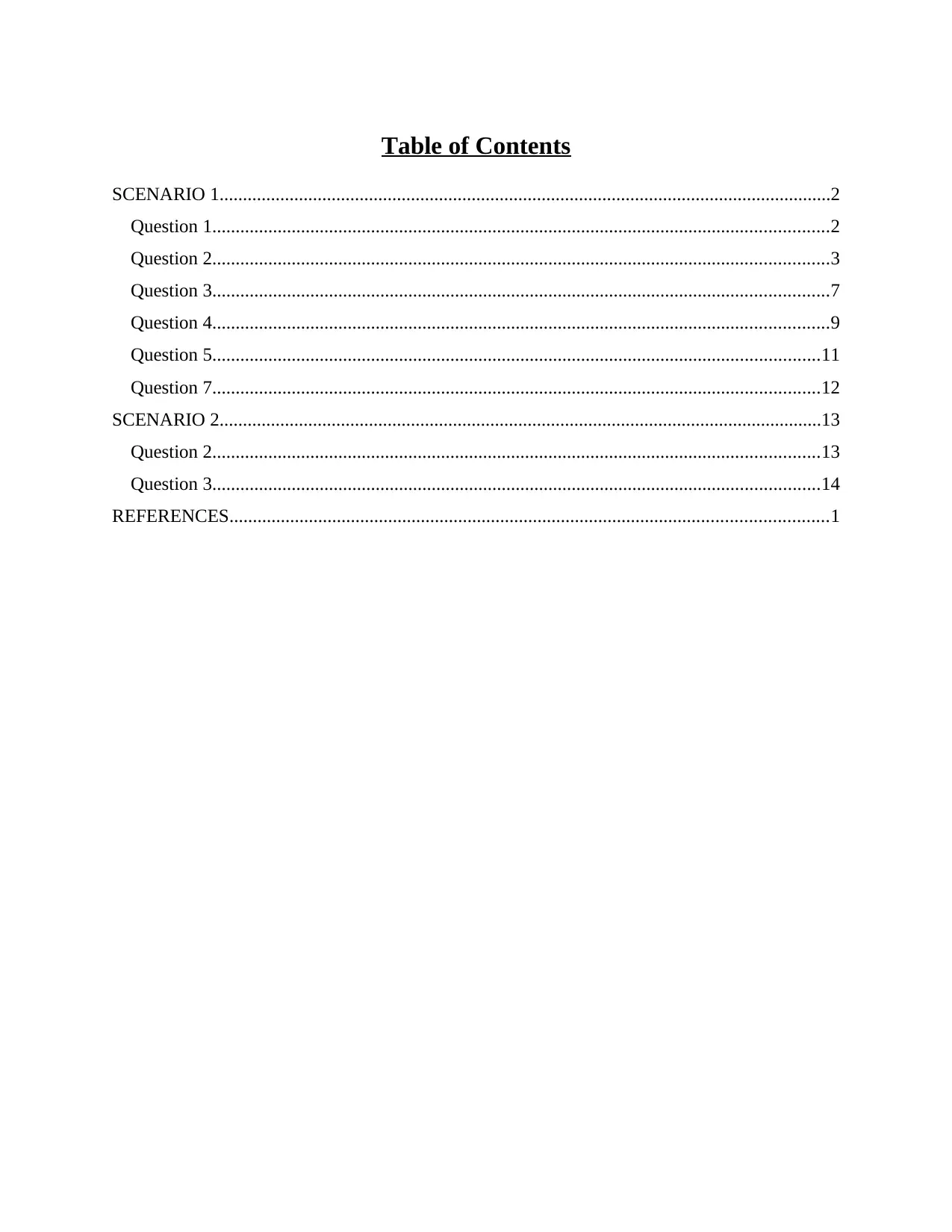
Table of Contents
SCENARIO 1...................................................................................................................................2
Question 1....................................................................................................................................2
Question 2....................................................................................................................................3
Question 3....................................................................................................................................7
Question 4....................................................................................................................................9
Question 5..................................................................................................................................11
Question 7..................................................................................................................................12
SCENARIO 2.................................................................................................................................13
Question 2..................................................................................................................................13
Question 3..................................................................................................................................14
REFERENCES................................................................................................................................1
SCENARIO 1...................................................................................................................................2
Question 1....................................................................................................................................2
Question 2....................................................................................................................................3
Question 3....................................................................................................................................7
Question 4....................................................................................................................................9
Question 5..................................................................................................................................11
Question 7..................................................................................................................................12
SCENARIO 2.................................................................................................................................13
Question 2..................................................................................................................................13
Question 3..................................................................................................................................14
REFERENCES................................................................................................................................1
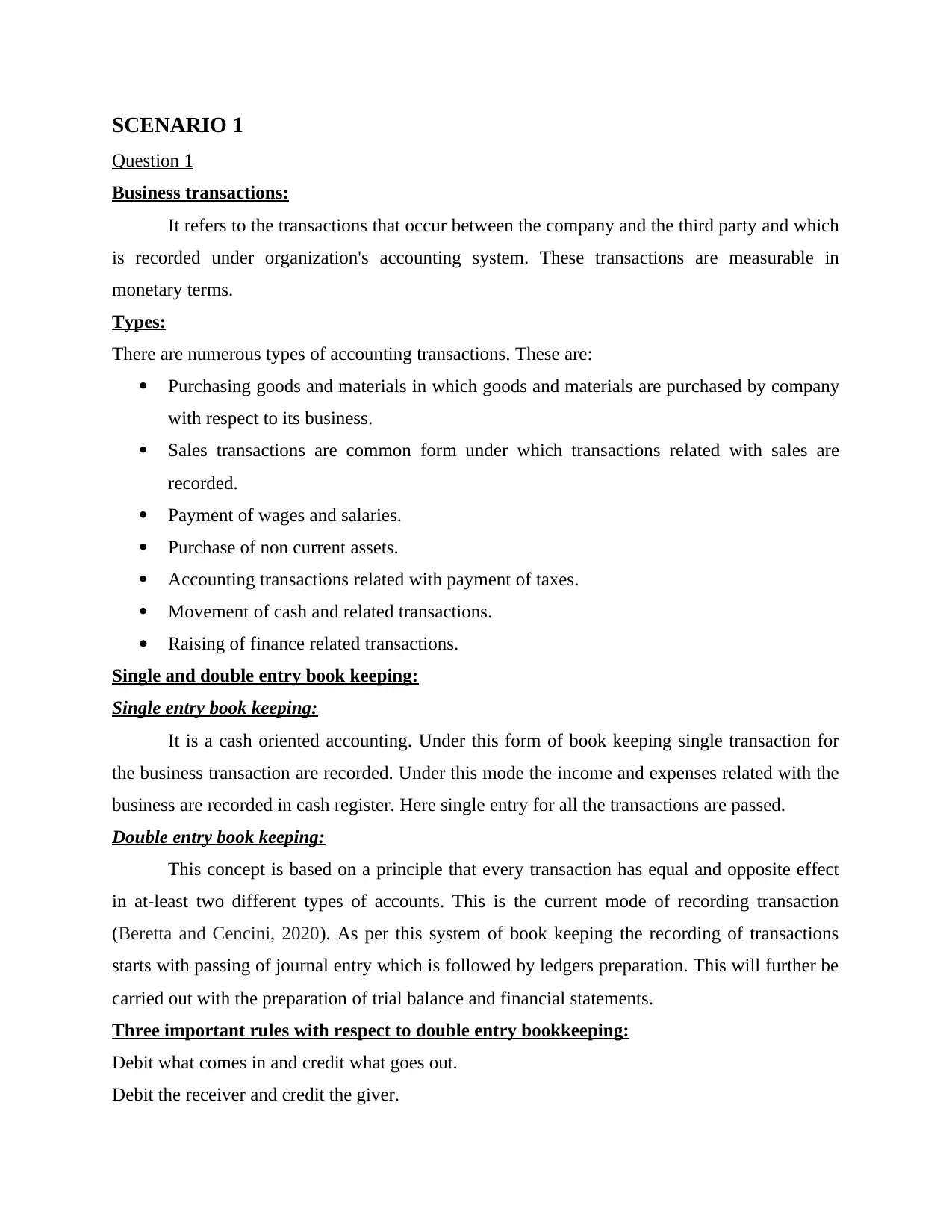
SCENARIO 1
Question 1
Business transactions:
It refers to the transactions that occur between the company and the third party and which
is recorded under organization's accounting system. These transactions are measurable in
monetary terms.
Types:
There are numerous types of accounting transactions. These are:
Purchasing goods and materials in which goods and materials are purchased by company
with respect to its business.
Sales transactions are common form under which transactions related with sales are
recorded.
Payment of wages and salaries.
Purchase of non current assets.
Accounting transactions related with payment of taxes.
Movement of cash and related transactions.
Raising of finance related transactions.
Single and double entry book keeping:
Single entry book keeping:
It is a cash oriented accounting. Under this form of book keeping single transaction for
the business transaction are recorded. Under this mode the income and expenses related with the
business are recorded in cash register. Here single entry for all the transactions are passed.
Double entry book keeping:
This concept is based on a principle that every transaction has equal and opposite effect
in at-least two different types of accounts. This is the current mode of recording transaction
(Beretta and Cencini, 2020). As per this system of book keeping the recording of transactions
starts with passing of journal entry which is followed by ledgers preparation. This will further be
carried out with the preparation of trial balance and financial statements.
Three important rules with respect to double entry bookkeeping:
Debit what comes in and credit what goes out.
Debit the receiver and credit the giver.
Question 1
Business transactions:
It refers to the transactions that occur between the company and the third party and which
is recorded under organization's accounting system. These transactions are measurable in
monetary terms.
Types:
There are numerous types of accounting transactions. These are:
Purchasing goods and materials in which goods and materials are purchased by company
with respect to its business.
Sales transactions are common form under which transactions related with sales are
recorded.
Payment of wages and salaries.
Purchase of non current assets.
Accounting transactions related with payment of taxes.
Movement of cash and related transactions.
Raising of finance related transactions.
Single and double entry book keeping:
Single entry book keeping:
It is a cash oriented accounting. Under this form of book keeping single transaction for
the business transaction are recorded. Under this mode the income and expenses related with the
business are recorded in cash register. Here single entry for all the transactions are passed.
Double entry book keeping:
This concept is based on a principle that every transaction has equal and opposite effect
in at-least two different types of accounts. This is the current mode of recording transaction
(Beretta and Cencini, 2020). As per this system of book keeping the recording of transactions
starts with passing of journal entry which is followed by ledgers preparation. This will further be
carried out with the preparation of trial balance and financial statements.
Three important rules with respect to double entry bookkeeping:
Debit what comes in and credit what goes out.
Debit the receiver and credit the giver.
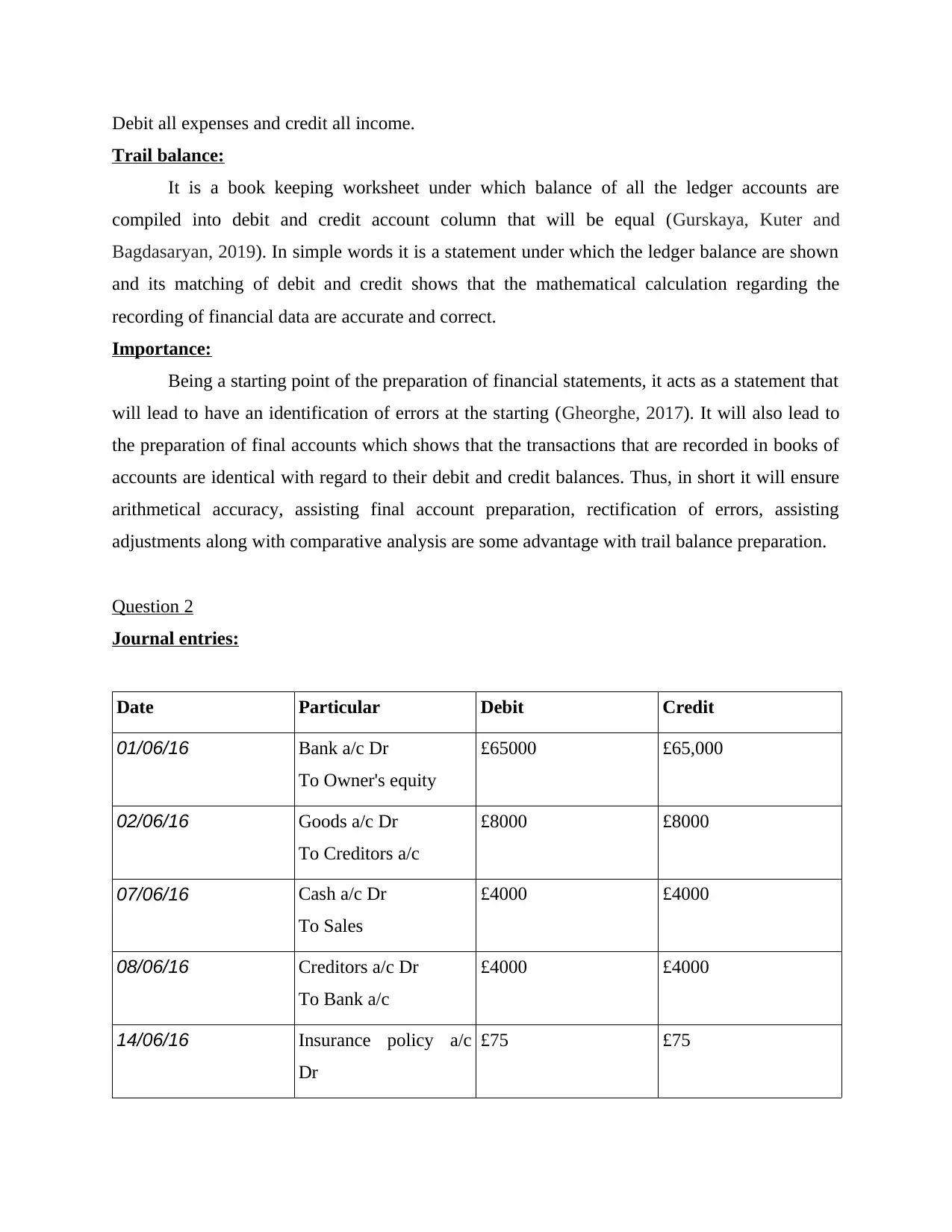
Debit all expenses and credit all income.
Trail balance:
It is a book keeping worksheet under which balance of all the ledger accounts are
compiled into debit and credit account column that will be equal (Gurskaya, Kuter and
Bagdasaryan, 2019). In simple words it is a statement under which the ledger balance are shown
and its matching of debit and credit shows that the mathematical calculation regarding the
recording of financial data are accurate and correct.
Importance:
Being a starting point of the preparation of financial statements, it acts as a statement that
will lead to have an identification of errors at the starting (Gheorghe, 2017). It will also lead to
the preparation of final accounts which shows that the transactions that are recorded in books of
accounts are identical with regard to their debit and credit balances. Thus, in short it will ensure
arithmetical accuracy, assisting final account preparation, rectification of errors, assisting
adjustments along with comparative analysis are some advantage with trail balance preparation.
Question 2
Journal entries:
Date Particular Debit Credit
01/06/16 Bank a/c Dr
To Owner's equity
£65000 £65,000
02/06/16 Goods a/c Dr
To Creditors a/c
£8000 £8000
07/06/16 Cash a/c Dr
To Sales
£4000 £4000
08/06/16 Creditors a/c Dr
To Bank a/c
£4000 £4000
14/06/16 Insurance policy a/c
Dr
£75 £75
Trail balance:
It is a book keeping worksheet under which balance of all the ledger accounts are
compiled into debit and credit account column that will be equal (Gurskaya, Kuter and
Bagdasaryan, 2019). In simple words it is a statement under which the ledger balance are shown
and its matching of debit and credit shows that the mathematical calculation regarding the
recording of financial data are accurate and correct.
Importance:
Being a starting point of the preparation of financial statements, it acts as a statement that
will lead to have an identification of errors at the starting (Gheorghe, 2017). It will also lead to
the preparation of final accounts which shows that the transactions that are recorded in books of
accounts are identical with regard to their debit and credit balances. Thus, in short it will ensure
arithmetical accuracy, assisting final account preparation, rectification of errors, assisting
adjustments along with comparative analysis are some advantage with trail balance preparation.
Question 2
Journal entries:
Date Particular Debit Credit
01/06/16 Bank a/c Dr
To Owner's equity
£65000 £65,000
02/06/16 Goods a/c Dr
To Creditors a/c
£8000 £8000
07/06/16 Cash a/c Dr
To Sales
£4000 £4000
08/06/16 Creditors a/c Dr
To Bank a/c
£4000 £4000
14/06/16 Insurance policy a/c
Dr
£75 £75
Secure Best Marks with AI Grader
Need help grading? Try our AI Grader for instant feedback on your assignments.

To Bank a/c
15/06/16 Creditors a/c
To Sales a/c
£12000 £12000
16/06/16 Goods a/c Dr
To Creditors a/c
£10000 £10000
18/06/16 Computer equipment
a/c Dr
To Cash a/c
£3000 £3000
20/06/16 Rent a/c Dr
To Bank a/c
£150 £150
21/06/16 Cash a/c Dr
To Sales a/c
£10000 £10000
25/06/16 Petty Cash tin a/c Dr
To Bank a/c
£100 £100
30/06/16 Stationary a/c Dr
To Petty Cash tin a/c
£30 £30
Ledger accounts:
Bank account
Date Particular Amount Date Particular Amount
01/06/16 Owner equity £65000 08/06/16 Creditors a/c £4000
21/06/16 Sales £10000 14/06/16 Insurance
policy a/c
£75
20/06/16 Rent a/c £150
25/06/16 Petty Cash tin
a/c
£100
15/06/16 Creditors a/c
To Sales a/c
£12000 £12000
16/06/16 Goods a/c Dr
To Creditors a/c
£10000 £10000
18/06/16 Computer equipment
a/c Dr
To Cash a/c
£3000 £3000
20/06/16 Rent a/c Dr
To Bank a/c
£150 £150
21/06/16 Cash a/c Dr
To Sales a/c
£10000 £10000
25/06/16 Petty Cash tin a/c Dr
To Bank a/c
£100 £100
30/06/16 Stationary a/c Dr
To Petty Cash tin a/c
£30 £30
Ledger accounts:
Bank account
Date Particular Amount Date Particular Amount
01/06/16 Owner equity £65000 08/06/16 Creditors a/c £4000
21/06/16 Sales £10000 14/06/16 Insurance
policy a/c
£75
20/06/16 Rent a/c £150
25/06/16 Petty Cash tin
a/c
£100
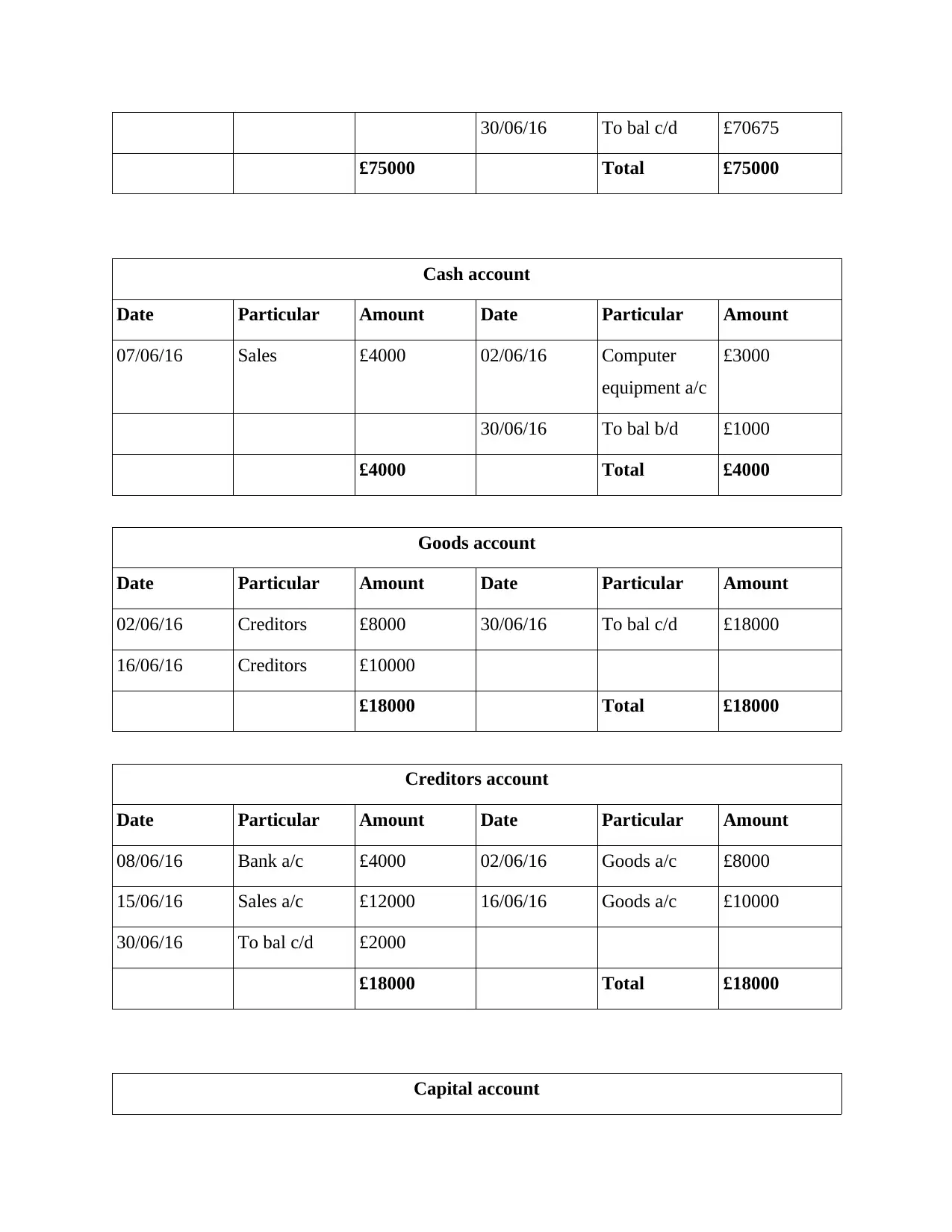
30/06/16 To bal c/d £70675
£75000 Total £75000
Cash account
Date Particular Amount Date Particular Amount
07/06/16 Sales £4000 02/06/16 Computer
equipment a/c
£3000
30/06/16 To bal b/d £1000
£4000 Total £4000
Goods account
Date Particular Amount Date Particular Amount
02/06/16 Creditors £8000 30/06/16 To bal c/d £18000
16/06/16 Creditors £10000
£18000 Total £18000
Creditors account
Date Particular Amount Date Particular Amount
08/06/16 Bank a/c £4000 02/06/16 Goods a/c £8000
15/06/16 Sales a/c £12000 16/06/16 Goods a/c £10000
30/06/16 To bal c/d £2000
£18000 Total £18000
Capital account
£75000 Total £75000
Cash account
Date Particular Amount Date Particular Amount
07/06/16 Sales £4000 02/06/16 Computer
equipment a/c
£3000
30/06/16 To bal b/d £1000
£4000 Total £4000
Goods account
Date Particular Amount Date Particular Amount
02/06/16 Creditors £8000 30/06/16 To bal c/d £18000
16/06/16 Creditors £10000
£18000 Total £18000
Creditors account
Date Particular Amount Date Particular Amount
08/06/16 Bank a/c £4000 02/06/16 Goods a/c £8000
15/06/16 Sales a/c £12000 16/06/16 Goods a/c £10000
30/06/16 To bal c/d £2000
£18000 Total £18000
Capital account
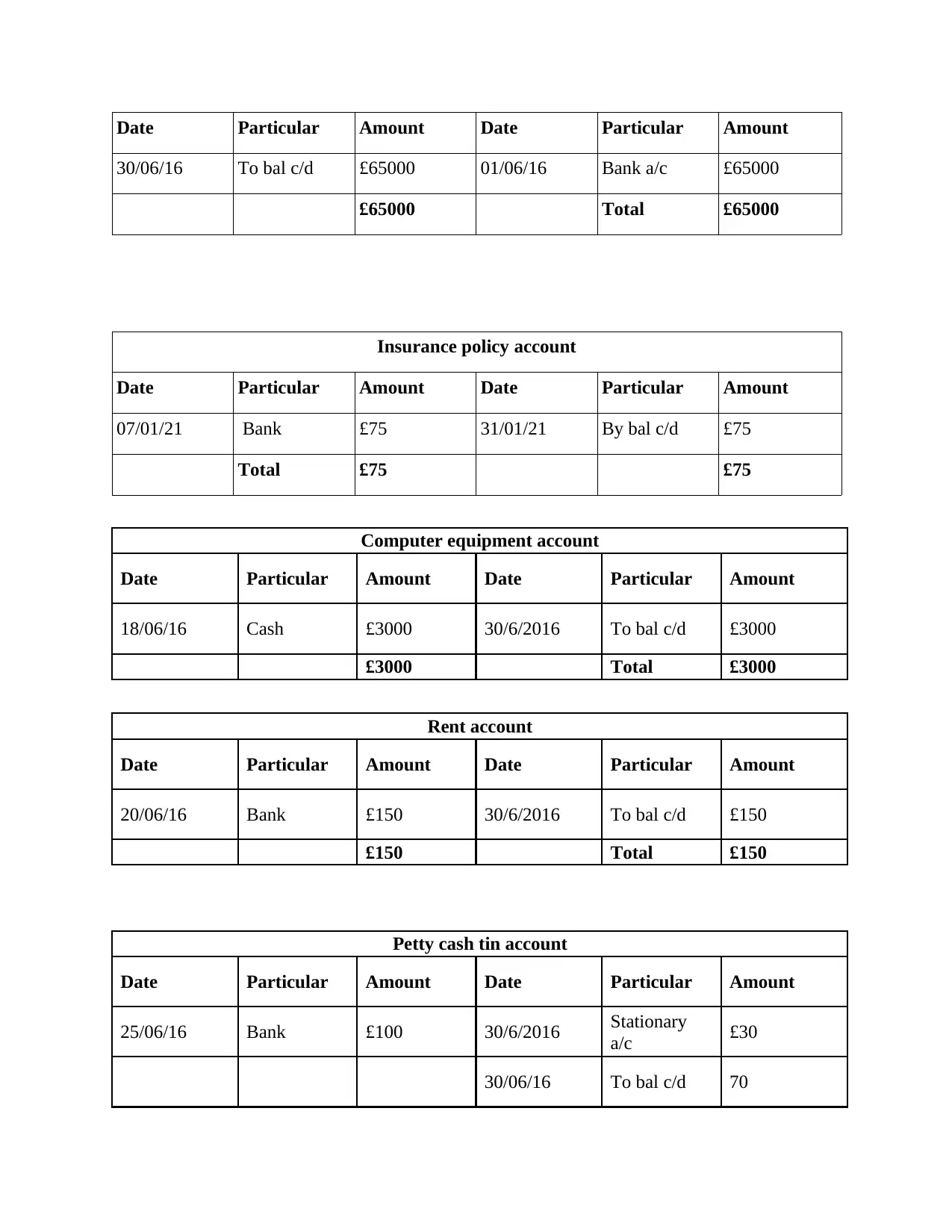
Date Particular Amount Date Particular Amount
30/06/16 To bal c/d £65000 01/06/16 Bank a/c £65000
£65000 Total £65000
Insurance policy account
Date Particular Amount Date Particular Amount
07/01/21 Bank £75 31/01/21 By bal c/d £75
Total £75 £75
Computer equipment account
Date Particular Amount Date Particular Amount
18/06/16 Cash £3000 30/6/2016 To bal c/d £3000
£3000 Total £3000
Rent account
Date Particular Amount Date Particular Amount
20/06/16 Bank £150 30/6/2016 To bal c/d £150
£150 Total £150
Petty cash tin account
Date Particular Amount Date Particular Amount
25/06/16 Bank £100 30/6/2016 Stationary
a/c £30
30/06/16 To bal c/d 70
30/06/16 To bal c/d £65000 01/06/16 Bank a/c £65000
£65000 Total £65000
Insurance policy account
Date Particular Amount Date Particular Amount
07/01/21 Bank £75 31/01/21 By bal c/d £75
Total £75 £75
Computer equipment account
Date Particular Amount Date Particular Amount
18/06/16 Cash £3000 30/6/2016 To bal c/d £3000
£3000 Total £3000
Rent account
Date Particular Amount Date Particular Amount
20/06/16 Bank £150 30/6/2016 To bal c/d £150
£150 Total £150
Petty cash tin account
Date Particular Amount Date Particular Amount
25/06/16 Bank £100 30/6/2016 Stationary
a/c £30
30/06/16 To bal c/d 70
Paraphrase This Document
Need a fresh take? Get an instant paraphrase of this document with our AI Paraphraser
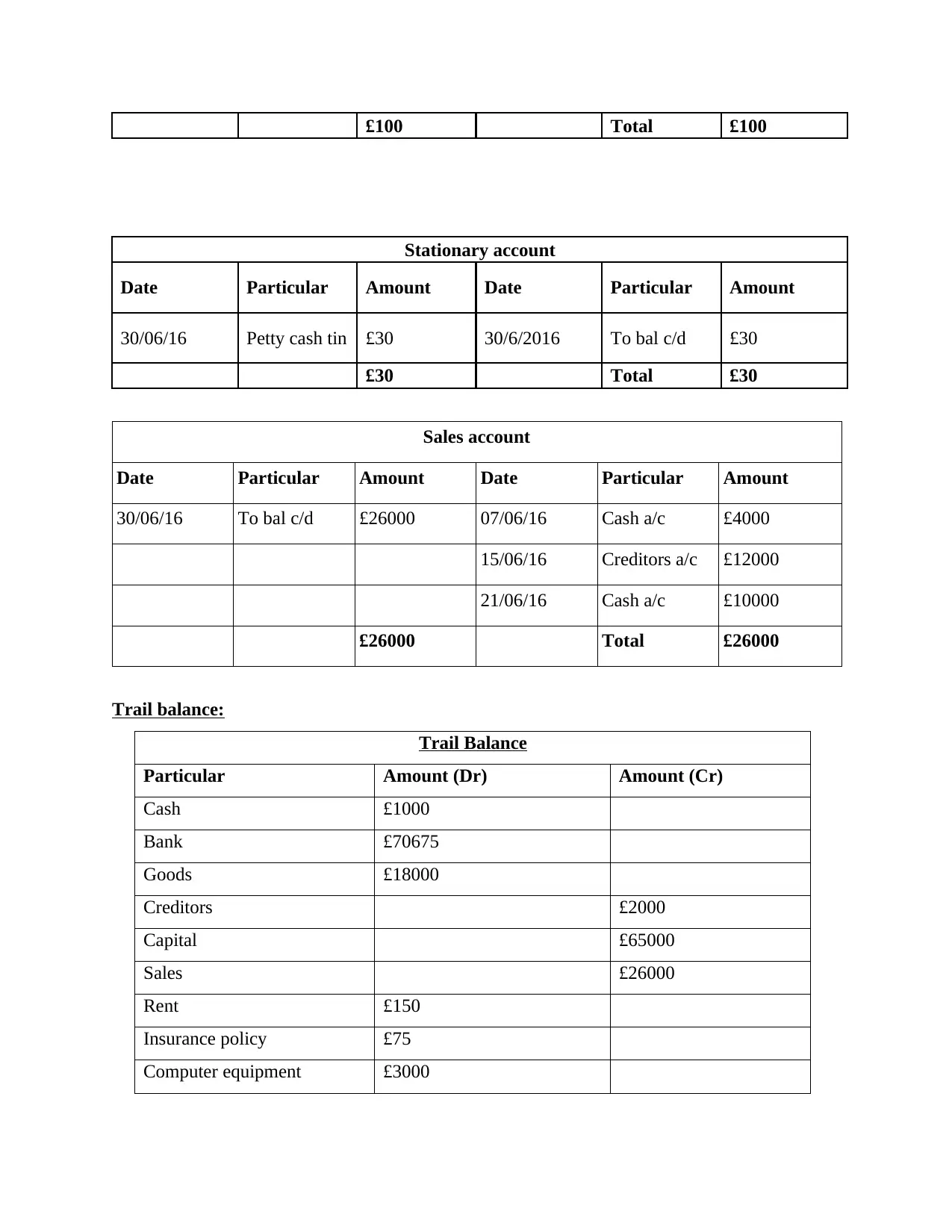
£100 Total £100
Stationary account
Date Particular Amount Date Particular Amount
30/06/16 Petty cash tin £30 30/6/2016 To bal c/d £30
£30 Total £30
Sales account
Date Particular Amount Date Particular Amount
30/06/16 To bal c/d £26000 07/06/16 Cash a/c £4000
15/06/16 Creditors a/c £12000
21/06/16 Cash a/c £10000
£26000 Total £26000
Trail balance:
Trail Balance
Particular Amount (Dr) Amount (Cr)
Cash £1000
Bank £70675
Goods £18000
Creditors £2000
Capital £65000
Sales £26000
Rent £150
Insurance policy £75
Computer equipment £3000
Stationary account
Date Particular Amount Date Particular Amount
30/06/16 Petty cash tin £30 30/6/2016 To bal c/d £30
£30 Total £30
Sales account
Date Particular Amount Date Particular Amount
30/06/16 To bal c/d £26000 07/06/16 Cash a/c £4000
15/06/16 Creditors a/c £12000
21/06/16 Cash a/c £10000
£26000 Total £26000
Trail balance:
Trail Balance
Particular Amount (Dr) Amount (Cr)
Cash £1000
Bank £70675
Goods £18000
Creditors £2000
Capital £65000
Sales £26000
Rent £150
Insurance policy £75
Computer equipment £3000
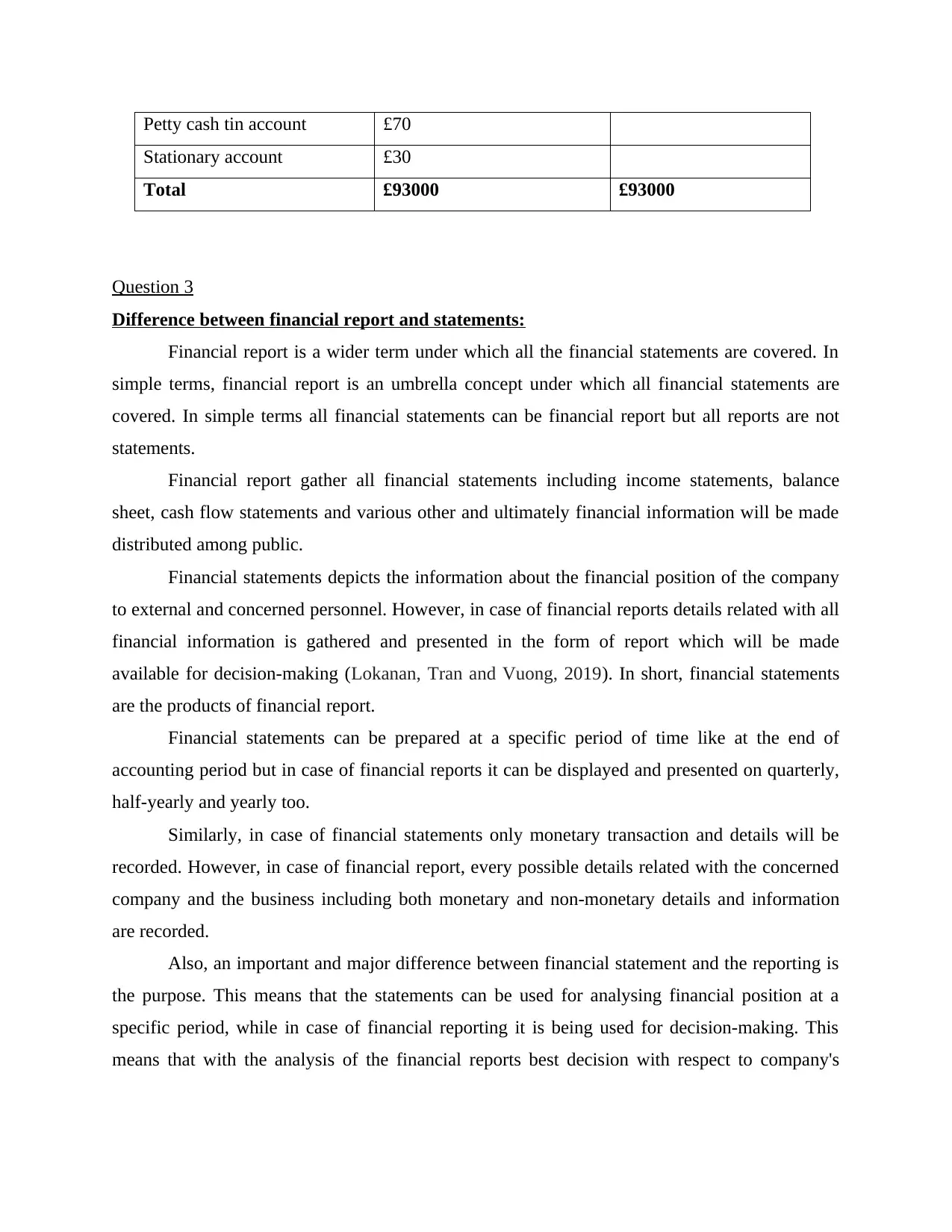
Petty cash tin account £70
Stationary account £30
Total £93000 £93000
Question 3
Difference between financial report and statements:
Financial report is a wider term under which all the financial statements are covered. In
simple terms, financial report is an umbrella concept under which all financial statements are
covered. In simple terms all financial statements can be financial report but all reports are not
statements.
Financial report gather all financial statements including income statements, balance
sheet, cash flow statements and various other and ultimately financial information will be made
distributed among public.
Financial statements depicts the information about the financial position of the company
to external and concerned personnel. However, in case of financial reports details related with all
financial information is gathered and presented in the form of report which will be made
available for decision-making (Lokanan, Tran and Vuong, 2019). In short, financial statements
are the products of financial report.
Financial statements can be prepared at a specific period of time like at the end of
accounting period but in case of financial reports it can be displayed and presented on quarterly,
half-yearly and yearly too.
Similarly, in case of financial statements only monetary transaction and details will be
recorded. However, in case of financial report, every possible details related with the concerned
company and the business including both monetary and non-monetary details and information
are recorded.
Also, an important and major difference between financial statement and the reporting is
the purpose. This means that the statements can be used for analysing financial position at a
specific period, while in case of financial reporting it is being used for decision-making. This
means that with the analysis of the financial reports best decision with respect to company's
Stationary account £30
Total £93000 £93000
Question 3
Difference between financial report and statements:
Financial report is a wider term under which all the financial statements are covered. In
simple terms, financial report is an umbrella concept under which all financial statements are
covered. In simple terms all financial statements can be financial report but all reports are not
statements.
Financial report gather all financial statements including income statements, balance
sheet, cash flow statements and various other and ultimately financial information will be made
distributed among public.
Financial statements depicts the information about the financial position of the company
to external and concerned personnel. However, in case of financial reports details related with all
financial information is gathered and presented in the form of report which will be made
available for decision-making (Lokanan, Tran and Vuong, 2019). In short, financial statements
are the products of financial report.
Financial statements can be prepared at a specific period of time like at the end of
accounting period but in case of financial reports it can be displayed and presented on quarterly,
half-yearly and yearly too.
Similarly, in case of financial statements only monetary transaction and details will be
recorded. However, in case of financial report, every possible details related with the concerned
company and the business including both monetary and non-monetary details and information
are recorded.
Also, an important and major difference between financial statement and the reporting is
the purpose. This means that the statements can be used for analysing financial position at a
specific period, while in case of financial reporting it is being used for decision-making. This
means that with the analysis of the financial reports best decision with respect to company's
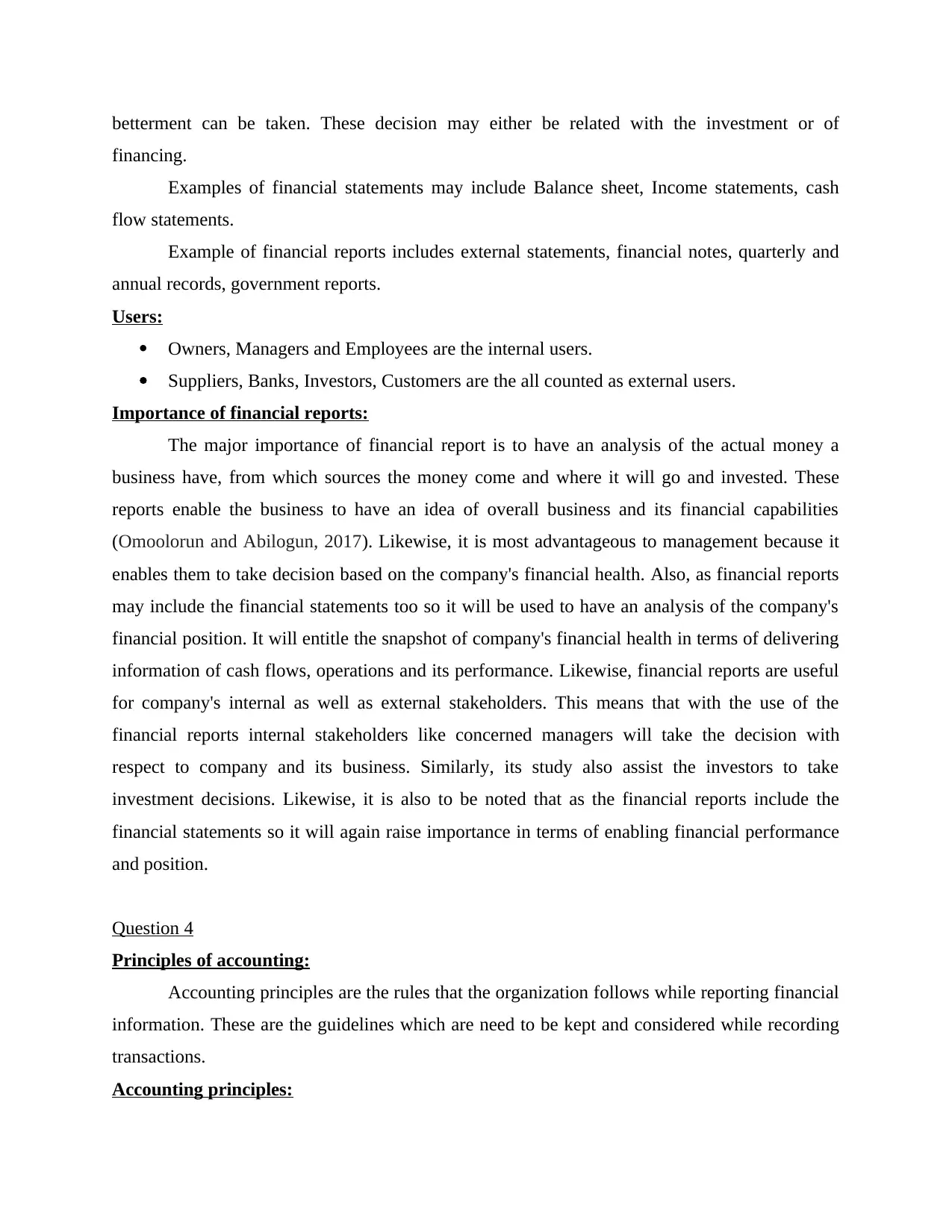
betterment can be taken. These decision may either be related with the investment or of
financing.
Examples of financial statements may include Balance sheet, Income statements, cash
flow statements.
Example of financial reports includes external statements, financial notes, quarterly and
annual records, government reports.
Users:
Owners, Managers and Employees are the internal users.
Suppliers, Banks, Investors, Customers are the all counted as external users.
Importance of financial reports:
The major importance of financial report is to have an analysis of the actual money a
business have, from which sources the money come and where it will go and invested. These
reports enable the business to have an idea of overall business and its financial capabilities
(Omoolorun and Abilogun, 2017). Likewise, it is most advantageous to management because it
enables them to take decision based on the company's financial health. Also, as financial reports
may include the financial statements too so it will be used to have an analysis of the company's
financial position. It will entitle the snapshot of company's financial health in terms of delivering
information of cash flows, operations and its performance. Likewise, financial reports are useful
for company's internal as well as external stakeholders. This means that with the use of the
financial reports internal stakeholders like concerned managers will take the decision with
respect to company and its business. Similarly, its study also assist the investors to take
investment decisions. Likewise, it is also to be noted that as the financial reports include the
financial statements so it will again raise importance in terms of enabling financial performance
and position.
Question 4
Principles of accounting:
Accounting principles are the rules that the organization follows while reporting financial
information. These are the guidelines which are need to be kept and considered while recording
transactions.
Accounting principles:
financing.
Examples of financial statements may include Balance sheet, Income statements, cash
flow statements.
Example of financial reports includes external statements, financial notes, quarterly and
annual records, government reports.
Users:
Owners, Managers and Employees are the internal users.
Suppliers, Banks, Investors, Customers are the all counted as external users.
Importance of financial reports:
The major importance of financial report is to have an analysis of the actual money a
business have, from which sources the money come and where it will go and invested. These
reports enable the business to have an idea of overall business and its financial capabilities
(Omoolorun and Abilogun, 2017). Likewise, it is most advantageous to management because it
enables them to take decision based on the company's financial health. Also, as financial reports
may include the financial statements too so it will be used to have an analysis of the company's
financial position. It will entitle the snapshot of company's financial health in terms of delivering
information of cash flows, operations and its performance. Likewise, financial reports are useful
for company's internal as well as external stakeholders. This means that with the use of the
financial reports internal stakeholders like concerned managers will take the decision with
respect to company and its business. Similarly, its study also assist the investors to take
investment decisions. Likewise, it is also to be noted that as the financial reports include the
financial statements so it will again raise importance in terms of enabling financial performance
and position.
Question 4
Principles of accounting:
Accounting principles are the rules that the organization follows while reporting financial
information. These are the guidelines which are need to be kept and considered while recording
transactions.
Accounting principles:
Secure Best Marks with AI Grader
Need help grading? Try our AI Grader for instant feedback on your assignments.

Accrual principle:
As per this principle accounting transactions will be recorded when they actually occur
rather than on the time when the payment and due will be received (Aqeel, Aws and Nawfal,
2020). This is the fundamental principle which assist that the financial statement shows the
details of all the transactions in an accounting period. This principle also assist the preparation of
financial statement in the respected accounting period. This means instead of delayed time and
lengthy process this principle suggest the recording of transaction within the respected
accounting period.
Conservatism principle:
This principle suggest that the expenses and liabilities are need to be recorded when they
have occurred. However, revenue and assets will be recorded only when there is surety related
with its occurrence. In short this principle focus on recording losses and expenses on early basis
rather than income. The concept related with this principle is that there may be delay in the
occurrence of revenue and profits, however expenses and liabilities occurred at the actual time.
Thus, recording of expenses at the actual time will predict a true image of company's financial
position.
Consistency principle:
As per this principle once a method of accounting and recording will be adopted then it
will needed to be carried out consistently (Shaw, 2021). This continuity will be carried out until
new and better principle will come across. This means that there will be no shuffling and shifting
of methods again and again.
Cost principle:
As per this principle the assets, liabilities and equity investments need to be recorded on
its original purchased cost. However, this principle is less valid because the host of accounting
standards shows that the assets and liabilities need to be recorded at face value.
Economic entity principle:
As per this principle the transactions of business and the owners will be recorded
separately. This principle prevent intermingling of business and its owner's transactions. This
will also safeguard the facing of difficulties when the accounts of the business will be audited.
Full disclosure principle:
As per this principle accounting transactions will be recorded when they actually occur
rather than on the time when the payment and due will be received (Aqeel, Aws and Nawfal,
2020). This is the fundamental principle which assist that the financial statement shows the
details of all the transactions in an accounting period. This principle also assist the preparation of
financial statement in the respected accounting period. This means instead of delayed time and
lengthy process this principle suggest the recording of transaction within the respected
accounting period.
Conservatism principle:
This principle suggest that the expenses and liabilities are need to be recorded when they
have occurred. However, revenue and assets will be recorded only when there is surety related
with its occurrence. In short this principle focus on recording losses and expenses on early basis
rather than income. The concept related with this principle is that there may be delay in the
occurrence of revenue and profits, however expenses and liabilities occurred at the actual time.
Thus, recording of expenses at the actual time will predict a true image of company's financial
position.
Consistency principle:
As per this principle once a method of accounting and recording will be adopted then it
will needed to be carried out consistently (Shaw, 2021). This continuity will be carried out until
new and better principle will come across. This means that there will be no shuffling and shifting
of methods again and again.
Cost principle:
As per this principle the assets, liabilities and equity investments need to be recorded on
its original purchased cost. However, this principle is less valid because the host of accounting
standards shows that the assets and liabilities need to be recorded at face value.
Economic entity principle:
As per this principle the transactions of business and the owners will be recorded
separately. This principle prevent intermingling of business and its owner's transactions. This
will also safeguard the facing of difficulties when the accounts of the business will be audited.
Full disclosure principle:
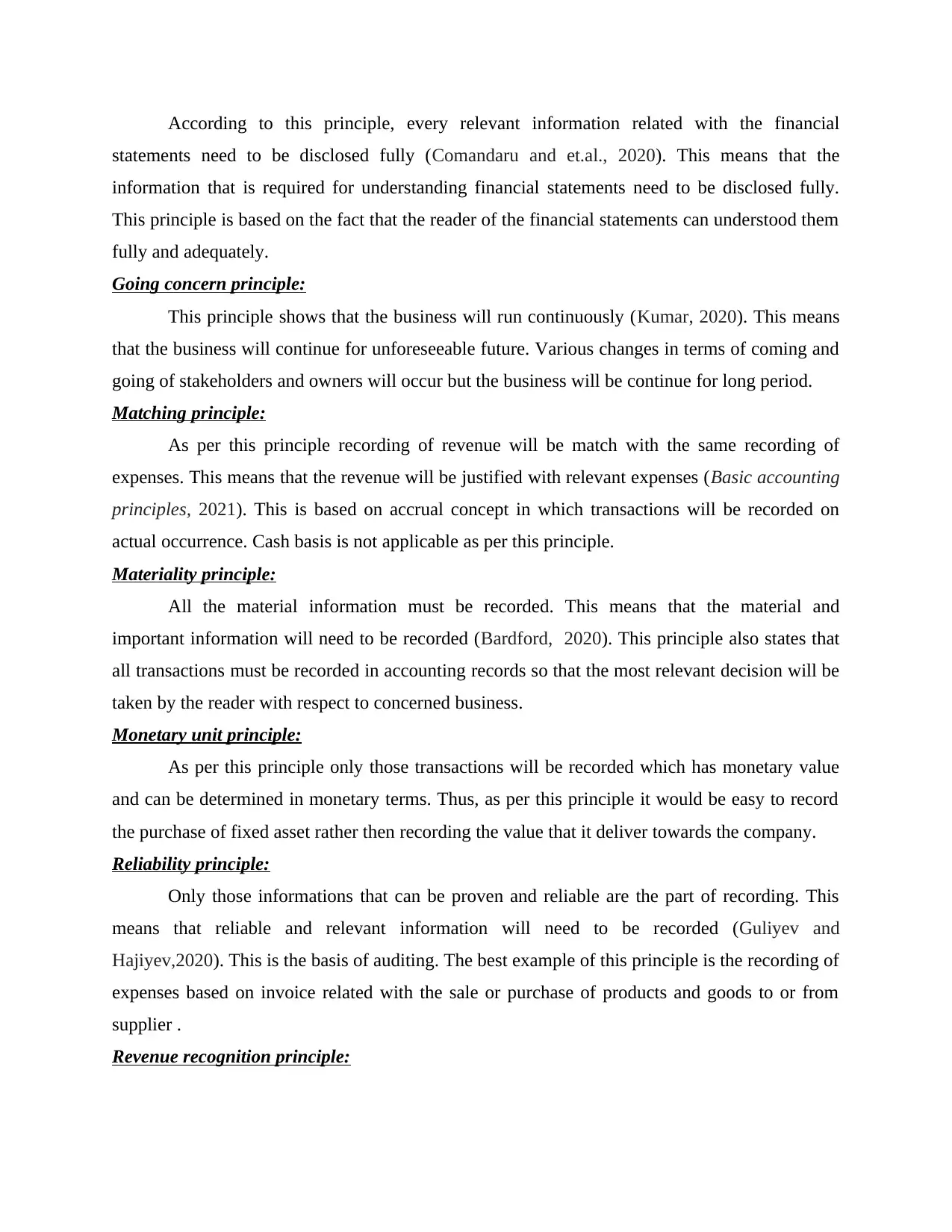
According to this principle, every relevant information related with the financial
statements need to be disclosed fully (Comandaru and et.al., 2020). This means that the
information that is required for understanding financial statements need to be disclosed fully.
This principle is based on the fact that the reader of the financial statements can understood them
fully and adequately.
Going concern principle:
This principle shows that the business will run continuously (Kumar, 2020). This means
that the business will continue for unforeseeable future. Various changes in terms of coming and
going of stakeholders and owners will occur but the business will be continue for long period.
Matching principle:
As per this principle recording of revenue will be match with the same recording of
expenses. This means that the revenue will be justified with relevant expenses (Basic accounting
principles, 2021). This is based on accrual concept in which transactions will be recorded on
actual occurrence. Cash basis is not applicable as per this principle.
Materiality principle:
All the material information must be recorded. This means that the material and
important information will need to be recorded (Bardford, 2020). This principle also states that
all transactions must be recorded in accounting records so that the most relevant decision will be
taken by the reader with respect to concerned business.
Monetary unit principle:
As per this principle only those transactions will be recorded which has monetary value
and can be determined in monetary terms. Thus, as per this principle it would be easy to record
the purchase of fixed asset rather then recording the value that it deliver towards the company.
Reliability principle:
Only those informations that can be proven and reliable are the part of recording. This
means that reliable and relevant information will need to be recorded (Guliyev and
Hajiyev,2020). This is the basis of auditing. The best example of this principle is the recording of
expenses based on invoice related with the sale or purchase of products and goods to or from
supplier .
Revenue recognition principle:
statements need to be disclosed fully (Comandaru and et.al., 2020). This means that the
information that is required for understanding financial statements need to be disclosed fully.
This principle is based on the fact that the reader of the financial statements can understood them
fully and adequately.
Going concern principle:
This principle shows that the business will run continuously (Kumar, 2020). This means
that the business will continue for unforeseeable future. Various changes in terms of coming and
going of stakeholders and owners will occur but the business will be continue for long period.
Matching principle:
As per this principle recording of revenue will be match with the same recording of
expenses. This means that the revenue will be justified with relevant expenses (Basic accounting
principles, 2021). This is based on accrual concept in which transactions will be recorded on
actual occurrence. Cash basis is not applicable as per this principle.
Materiality principle:
All the material information must be recorded. This means that the material and
important information will need to be recorded (Bardford, 2020). This principle also states that
all transactions must be recorded in accounting records so that the most relevant decision will be
taken by the reader with respect to concerned business.
Monetary unit principle:
As per this principle only those transactions will be recorded which has monetary value
and can be determined in monetary terms. Thus, as per this principle it would be easy to record
the purchase of fixed asset rather then recording the value that it deliver towards the company.
Reliability principle:
Only those informations that can be proven and reliable are the part of recording. This
means that reliable and relevant information will need to be recorded (Guliyev and
Hajiyev,2020). This is the basis of auditing. The best example of this principle is the recording of
expenses based on invoice related with the sale or purchase of products and goods to or from
supplier .
Revenue recognition principle:
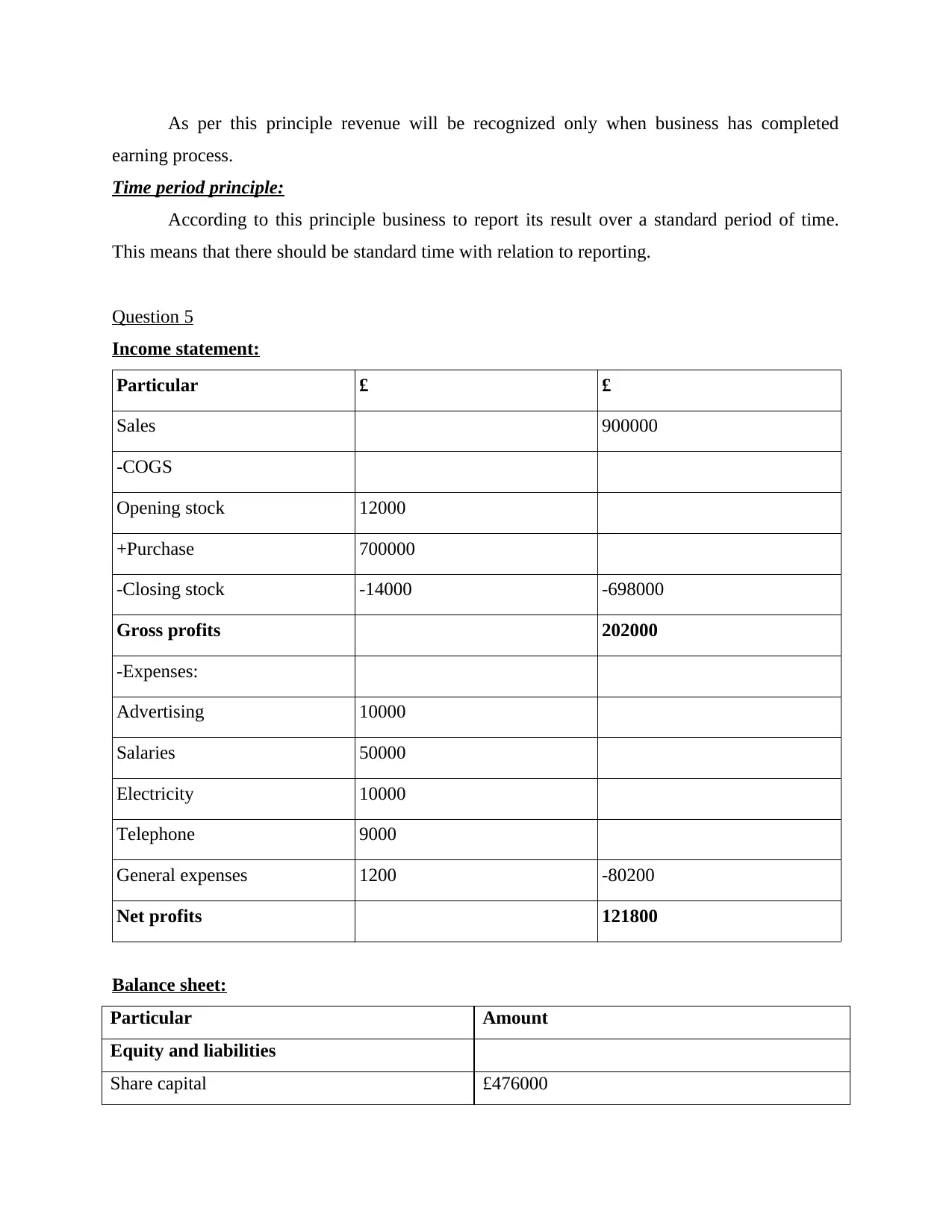
As per this principle revenue will be recognized only when business has completed
earning process.
Time period principle:
According to this principle business to report its result over a standard period of time.
This means that there should be standard time with relation to reporting.
Question 5
Income statement:
Particular £ £
Sales 900000
-COGS
Opening stock 12000
+Purchase 700000
-Closing stock -14000 -698000
Gross profits 202000
-Expenses:
Advertising 10000
Salaries 50000
Electricity 10000
Telephone 9000
General expenses 1200 -80200
Net profits 121800
Balance sheet:
Particular Amount
Equity and liabilities
Share capital £476000
earning process.
Time period principle:
According to this principle business to report its result over a standard period of time.
This means that there should be standard time with relation to reporting.
Question 5
Income statement:
Particular £ £
Sales 900000
-COGS
Opening stock 12000
+Purchase 700000
-Closing stock -14000 -698000
Gross profits 202000
-Expenses:
Advertising 10000
Salaries 50000
Electricity 10000
Telephone 9000
General expenses 1200 -80200
Net profits 121800
Balance sheet:
Particular Amount
Equity and liabilities
Share capital £476000
Paraphrase This Document
Need a fresh take? Get an instant paraphrase of this document with our AI Paraphraser
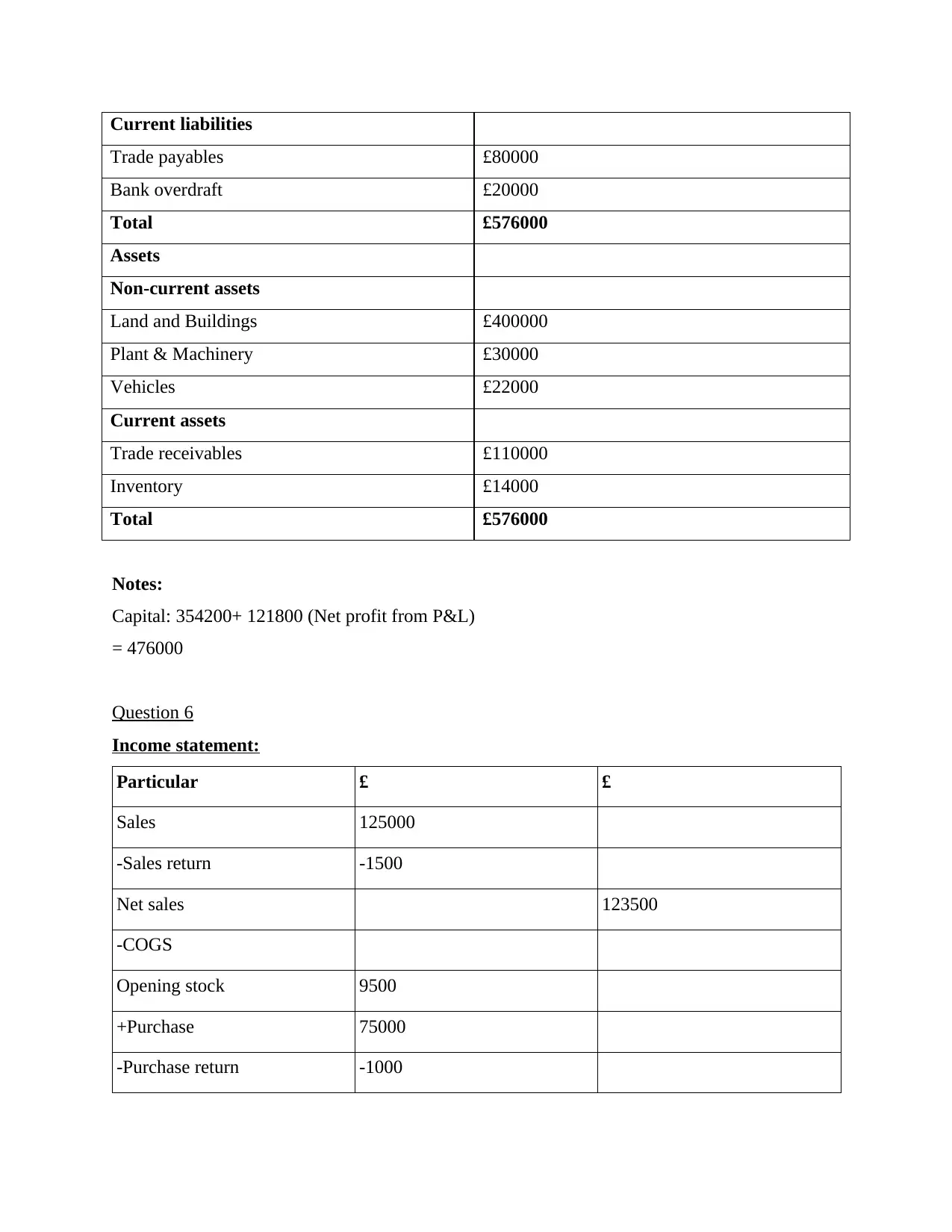
Current liabilities
Trade payables £80000
Bank overdraft £20000
Total £576000
Assets
Non-current assets
Land and Buildings £400000
Plant & Machinery £30000
Vehicles £22000
Current assets
Trade receivables £110000
Inventory £14000
Total £576000
Notes:
Capital: 354200+ 121800 (Net profit from P&L)
= 476000
Question 6
Income statement:
Particular £ £
Sales 125000
-Sales return -1500
Net sales 123500
-COGS
Opening stock 9500
+Purchase 75000
-Purchase return -1000
Trade payables £80000
Bank overdraft £20000
Total £576000
Assets
Non-current assets
Land and Buildings £400000
Plant & Machinery £30000
Vehicles £22000
Current assets
Trade receivables £110000
Inventory £14000
Total £576000
Notes:
Capital: 354200+ 121800 (Net profit from P&L)
= 476000
Question 6
Income statement:
Particular £ £
Sales 125000
-Sales return -1500
Net sales 123500
-COGS
Opening stock 9500
+Purchase 75000
-Purchase return -1000
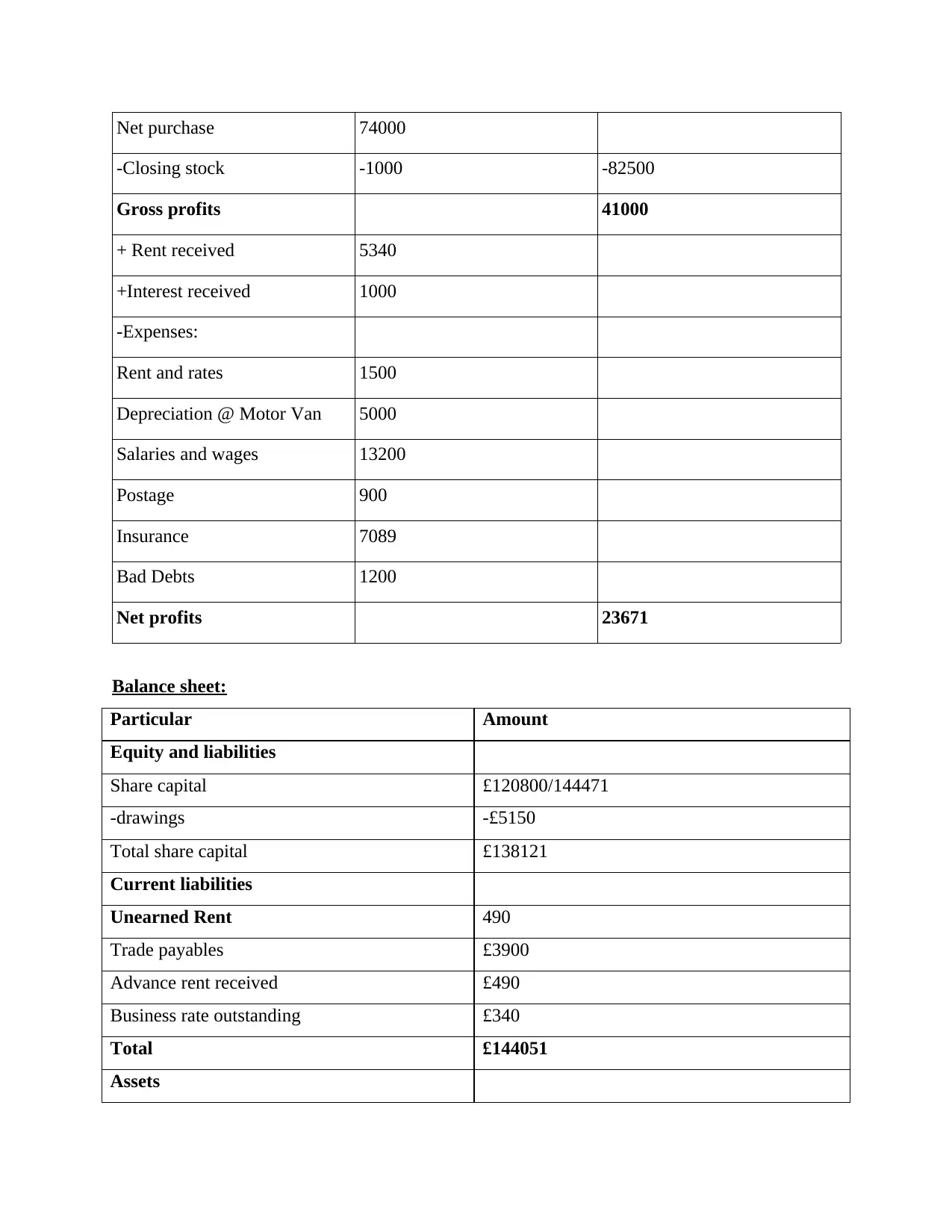
Net purchase 74000
-Closing stock -1000 -82500
Gross profits 41000
+ Rent received 5340
+Interest received 1000
-Expenses:
Rent and rates 1500
Depreciation @ Motor Van 5000
Salaries and wages 13200
Postage 900
Insurance 7089
Bad Debts 1200
Net profits 23671
Balance sheet:
Particular Amount
Equity and liabilities
Share capital £120800/144471
-drawings -£5150
Total share capital £138121
Current liabilities
Unearned Rent 490
Trade payables £3900
Advance rent received £490
Business rate outstanding £340
Total £144051
Assets
-Closing stock -1000 -82500
Gross profits 41000
+ Rent received 5340
+Interest received 1000
-Expenses:
Rent and rates 1500
Depreciation @ Motor Van 5000
Salaries and wages 13200
Postage 900
Insurance 7089
Bad Debts 1200
Net profits 23671
Balance sheet:
Particular Amount
Equity and liabilities
Share capital £120800/144471
-drawings -£5150
Total share capital £138121
Current liabilities
Unearned Rent 490
Trade payables £3900
Advance rent received £490
Business rate outstanding £340
Total £144051
Assets
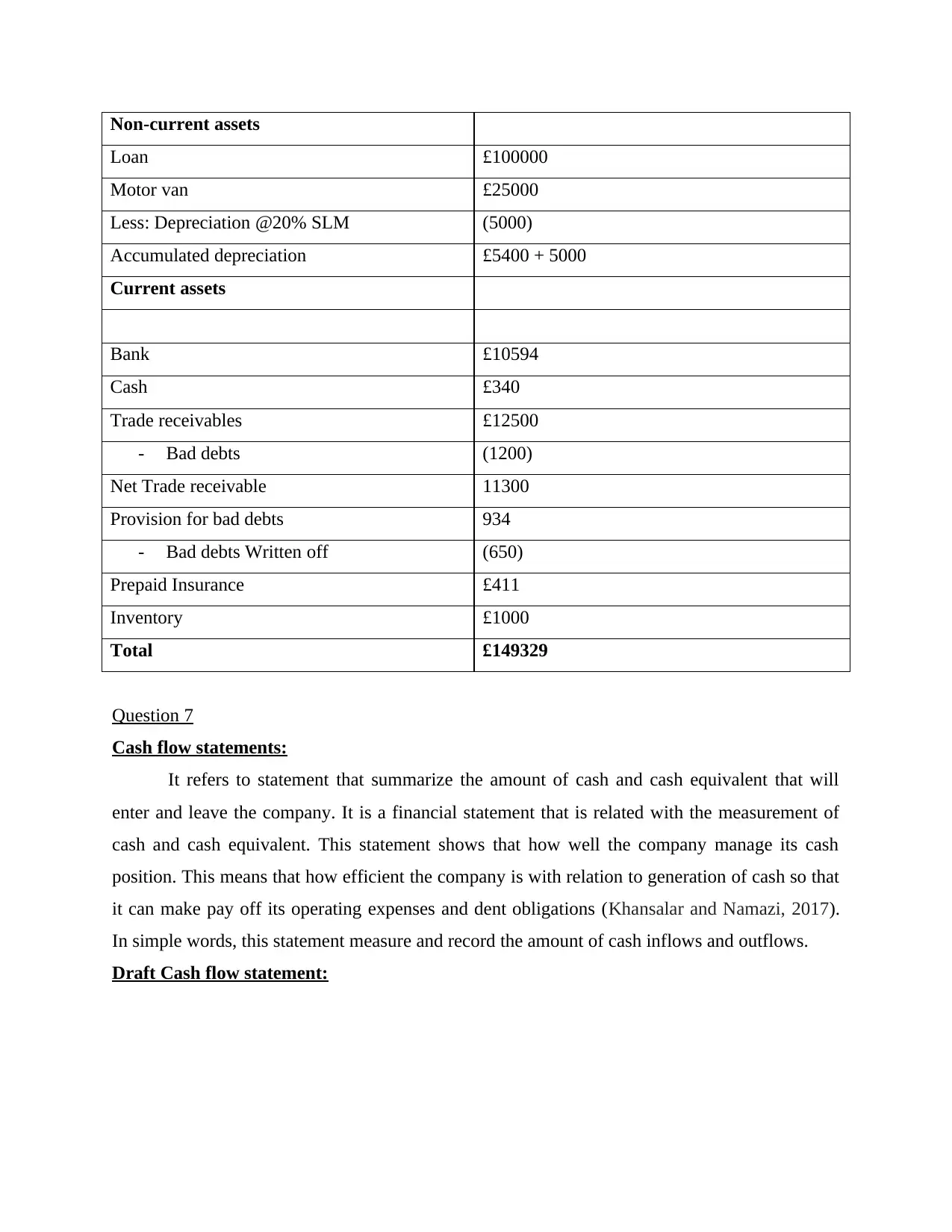
Non-current assets
Loan £100000
Motor van £25000
Less: Depreciation @20% SLM (5000)
Accumulated depreciation £5400 + 5000
Current assets
Bank £10594
Cash £340
Trade receivables £12500
- Bad debts (1200)
Net Trade receivable 11300
Provision for bad debts 934
- Bad debts Written off (650)
Prepaid Insurance £411
Inventory £1000
Total £149329
Question 7
Cash flow statements:
It refers to statement that summarize the amount of cash and cash equivalent that will
enter and leave the company. It is a financial statement that is related with the measurement of
cash and cash equivalent. This statement shows that how well the company manage its cash
position. This means that how efficient the company is with relation to generation of cash so that
it can make pay off its operating expenses and dent obligations (Khansalar and Namazi, 2017).
In simple words, this statement measure and record the amount of cash inflows and outflows.
Draft Cash flow statement:
Loan £100000
Motor van £25000
Less: Depreciation @20% SLM (5000)
Accumulated depreciation £5400 + 5000
Current assets
Bank £10594
Cash £340
Trade receivables £12500
- Bad debts (1200)
Net Trade receivable 11300
Provision for bad debts 934
- Bad debts Written off (650)
Prepaid Insurance £411
Inventory £1000
Total £149329
Question 7
Cash flow statements:
It refers to statement that summarize the amount of cash and cash equivalent that will
enter and leave the company. It is a financial statement that is related with the measurement of
cash and cash equivalent. This statement shows that how well the company manage its cash
position. This means that how efficient the company is with relation to generation of cash so that
it can make pay off its operating expenses and dent obligations (Khansalar and Namazi, 2017).
In simple words, this statement measure and record the amount of cash inflows and outflows.
Draft Cash flow statement:
Secure Best Marks with AI Grader
Need help grading? Try our AI Grader for instant feedback on your assignments.
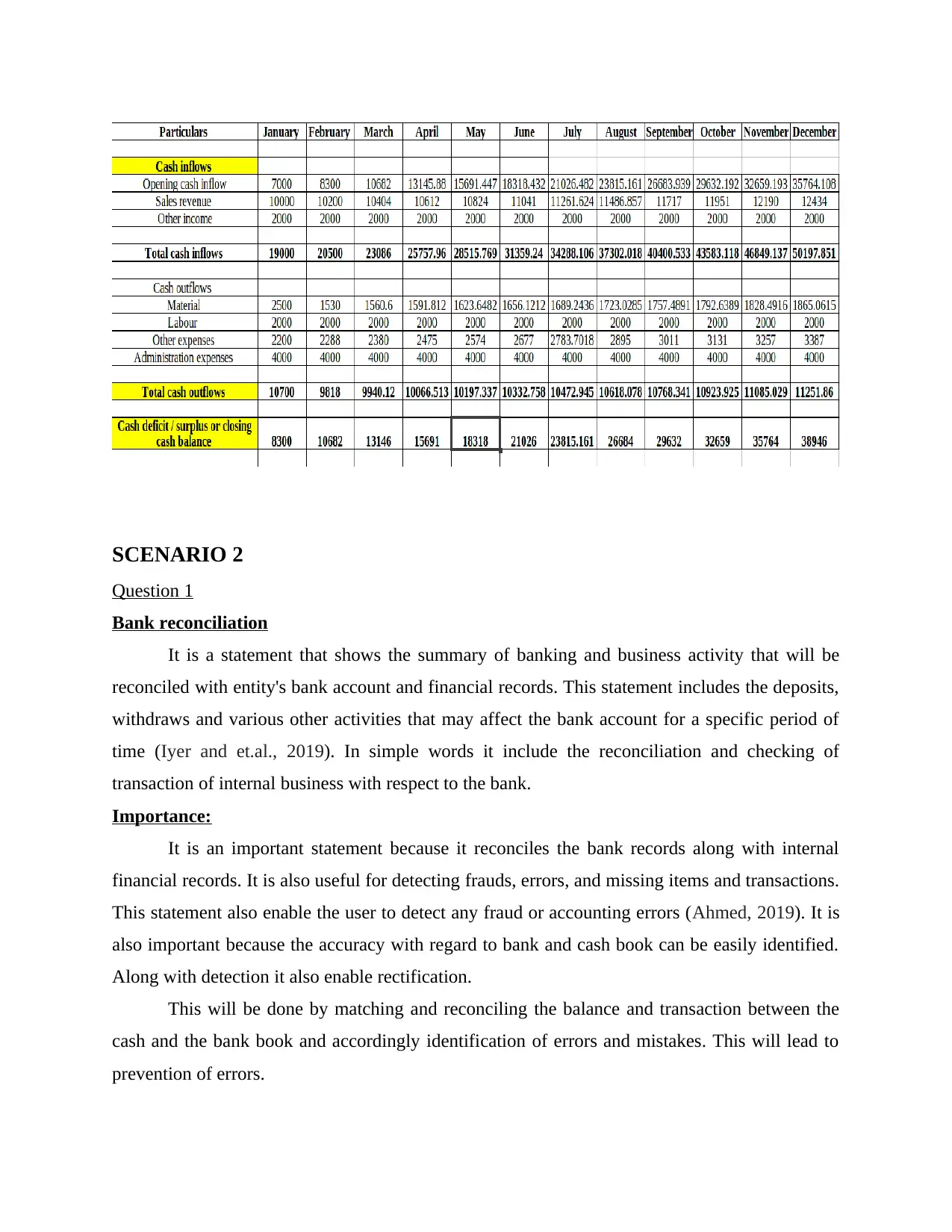
SCENARIO 2
Question 1
Bank reconciliation
It is a statement that shows the summary of banking and business activity that will be
reconciled with entity's bank account and financial records. This statement includes the deposits,
withdraws and various other activities that may affect the bank account for a specific period of
time (Iyer and et.al., 2019). In simple words it include the reconciliation and checking of
transaction of internal business with respect to the bank.
Importance:
It is an important statement because it reconciles the bank records along with internal
financial records. It is also useful for detecting frauds, errors, and missing items and transactions.
This statement also enable the user to detect any fraud or accounting errors (Ahmed, 2019). It is
also important because the accuracy with regard to bank and cash book can be easily identified.
Along with detection it also enable rectification.
This will be done by matching and reconciling the balance and transaction between the
cash and the bank book and accordingly identification of errors and mistakes. This will lead to
prevention of errors.
Question 1
Bank reconciliation
It is a statement that shows the summary of banking and business activity that will be
reconciled with entity's bank account and financial records. This statement includes the deposits,
withdraws and various other activities that may affect the bank account for a specific period of
time (Iyer and et.al., 2019). In simple words it include the reconciliation and checking of
transaction of internal business with respect to the bank.
Importance:
It is an important statement because it reconciles the bank records along with internal
financial records. It is also useful for detecting frauds, errors, and missing items and transactions.
This statement also enable the user to detect any fraud or accounting errors (Ahmed, 2019). It is
also important because the accuracy with regard to bank and cash book can be easily identified.
Along with detection it also enable rectification.
This will be done by matching and reconciling the balance and transaction between the
cash and the bank book and accordingly identification of errors and mistakes. This will lead to
prevention of errors.
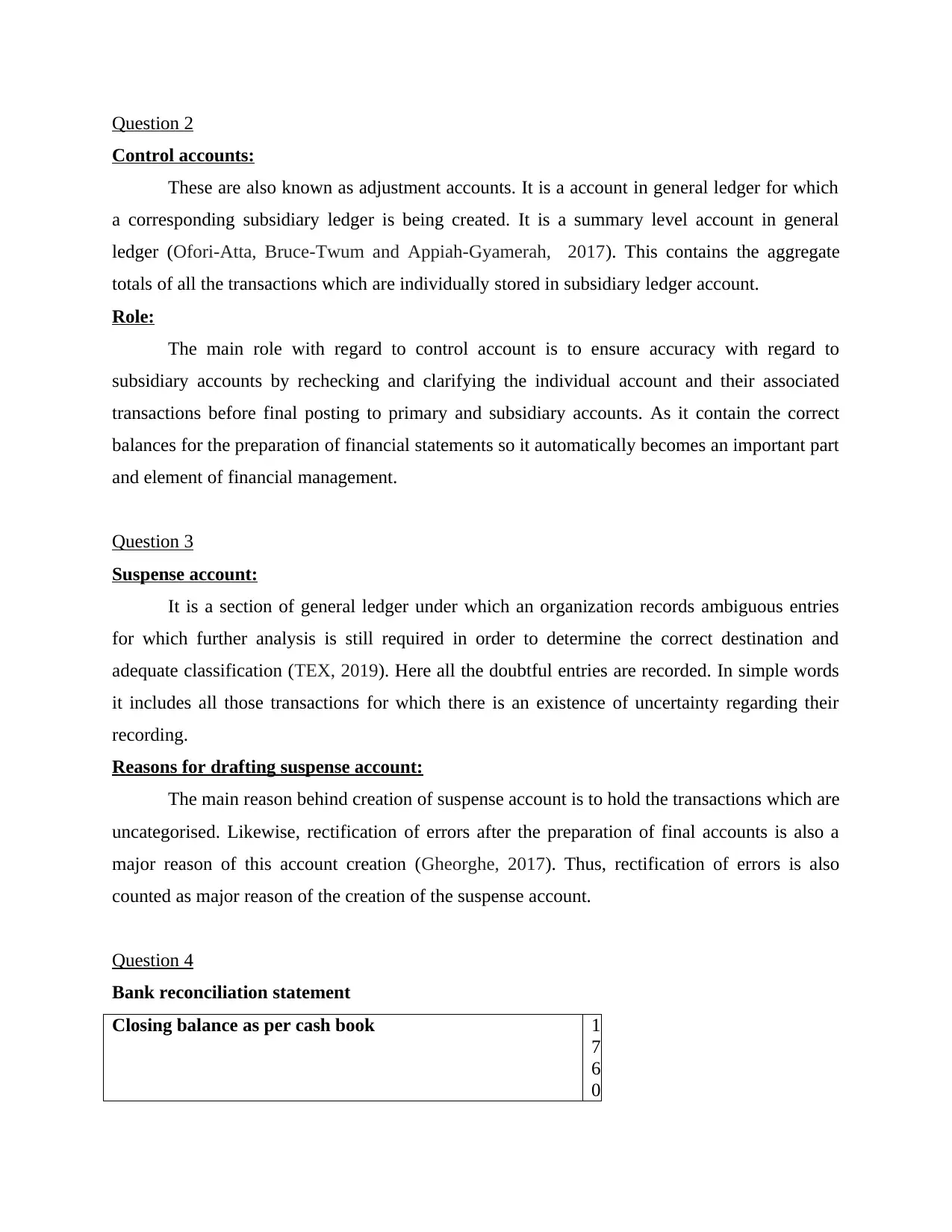
Question 2
Control accounts:
These are also known as adjustment accounts. It is a account in general ledger for which
a corresponding subsidiary ledger is being created. It is a summary level account in general
ledger (Ofori-Atta, Bruce-Twum and Appiah-Gyamerah, 2017). This contains the aggregate
totals of all the transactions which are individually stored in subsidiary ledger account.
Role:
The main role with regard to control account is to ensure accuracy with regard to
subsidiary accounts by rechecking and clarifying the individual account and their associated
transactions before final posting to primary and subsidiary accounts. As it contain the correct
balances for the preparation of financial statements so it automatically becomes an important part
and element of financial management.
Question 3
Suspense account:
It is a section of general ledger under which an organization records ambiguous entries
for which further analysis is still required in order to determine the correct destination and
adequate classification (TEX, 2019). Here all the doubtful entries are recorded. In simple words
it includes all those transactions for which there is an existence of uncertainty regarding their
recording.
Reasons for drafting suspense account:
The main reason behind creation of suspense account is to hold the transactions which are
uncategorised. Likewise, rectification of errors after the preparation of final accounts is also a
major reason of this account creation (Gheorghe, 2017). Thus, rectification of errors is also
counted as major reason of the creation of the suspense account.
Question 4
Bank reconciliation statement
Closing balance as per cash book 1
7
6
0
Control accounts:
These are also known as adjustment accounts. It is a account in general ledger for which
a corresponding subsidiary ledger is being created. It is a summary level account in general
ledger (Ofori-Atta, Bruce-Twum and Appiah-Gyamerah, 2017). This contains the aggregate
totals of all the transactions which are individually stored in subsidiary ledger account.
Role:
The main role with regard to control account is to ensure accuracy with regard to
subsidiary accounts by rechecking and clarifying the individual account and their associated
transactions before final posting to primary and subsidiary accounts. As it contain the correct
balances for the preparation of financial statements so it automatically becomes an important part
and element of financial management.
Question 3
Suspense account:
It is a section of general ledger under which an organization records ambiguous entries
for which further analysis is still required in order to determine the correct destination and
adequate classification (TEX, 2019). Here all the doubtful entries are recorded. In simple words
it includes all those transactions for which there is an existence of uncertainty regarding their
recording.
Reasons for drafting suspense account:
The main reason behind creation of suspense account is to hold the transactions which are
uncategorised. Likewise, rectification of errors after the preparation of final accounts is also a
major reason of this account creation (Gheorghe, 2017). Thus, rectification of errors is also
counted as major reason of the creation of the suspense account.
Question 4
Bank reconciliation statement
Closing balance as per cash book 1
7
6
0

Mr patel transfer 1070
Insurance paid (170)
Talk talk bill paid (56)
Dividend collected 325
Bank charges (25) 1144
Balance as per pass book 2904
Terms
Debit and standing order
Debit is a term in account that allows any stakeholder to take a certain amount or a value
on a notified date over a bank account of the organisation. This is like an authority to the
respective party to claim a certain value in the company bank balance over a notified date or
period. The debit is a official right over the person bank account that the respective party or the
authority will get a respective balance or amount over a given date or period. This is an
important part of the accounting transactions and principles of accounting that it allow a legal
right to the respective party (O’Neal and O'Neal, 2018). In the normal business circumstances the
debit has significant values that allow the stakeholder to channelizes and smooth the business
transactions.
On the other hand the standing order is about to instruct the bank to pay a certain value or
balance to the respective party on a given date. Both the elements are different from each other.
One is to allow someone to claim a certain balance and the other one is to instruct the bank to
pay a certain value to the person claiming the respective value. Both the aspects and factors or
elements are different from each other. In both the situation the personal eligible for the
respective amount will get a value from the bank but the situation is completely different (Rafati
and Derde, 2017). When it comes to debit the bank does not need to ask the account holder about
paying the value but when uit comes to standing order bank require an official authority of the
account holder to pay the respective balance or value. The condition in both the situation is
different from each other. This is important to understand both the concepts. In the normal
business affairs both the concepts and factors create a significant smoothness in making or
enhancing the value of the business affairs. Debit and standing order are the key part of every
business house as it creates a significant edge in delivering the business operations in a smooth
manner. This is important for the business houses to create smoothness in its business
Insurance paid (170)
Talk talk bill paid (56)
Dividend collected 325
Bank charges (25) 1144
Balance as per pass book 2904
Terms
Debit and standing order
Debit is a term in account that allows any stakeholder to take a certain amount or a value
on a notified date over a bank account of the organisation. This is like an authority to the
respective party to claim a certain value in the company bank balance over a notified date or
period. The debit is a official right over the person bank account that the respective party or the
authority will get a respective balance or amount over a given date or period. This is an
important part of the accounting transactions and principles of accounting that it allow a legal
right to the respective party (O’Neal and O'Neal, 2018). In the normal business circumstances the
debit has significant values that allow the stakeholder to channelizes and smooth the business
transactions.
On the other hand the standing order is about to instruct the bank to pay a certain value or
balance to the respective party on a given date. Both the elements are different from each other.
One is to allow someone to claim a certain balance and the other one is to instruct the bank to
pay a certain value to the person claiming the respective value. Both the aspects and factors or
elements are different from each other. In both the situation the personal eligible for the
respective amount will get a value from the bank but the situation is completely different (Rafati
and Derde, 2017). When it comes to debit the bank does not need to ask the account holder about
paying the value but when uit comes to standing order bank require an official authority of the
account holder to pay the respective balance or value. The condition in both the situation is
different from each other. This is important to understand both the concepts. In the normal
business affairs both the concepts and factors create a significant smoothness in making or
enhancing the value of the business affairs. Debit and standing order are the key part of every
business house as it creates a significant edge in delivering the business operations in a smooth
manner. This is important for the business houses to create smoothness in its business
Paraphrase This Document
Need a fresh take? Get an instant paraphrase of this document with our AI Paraphraser
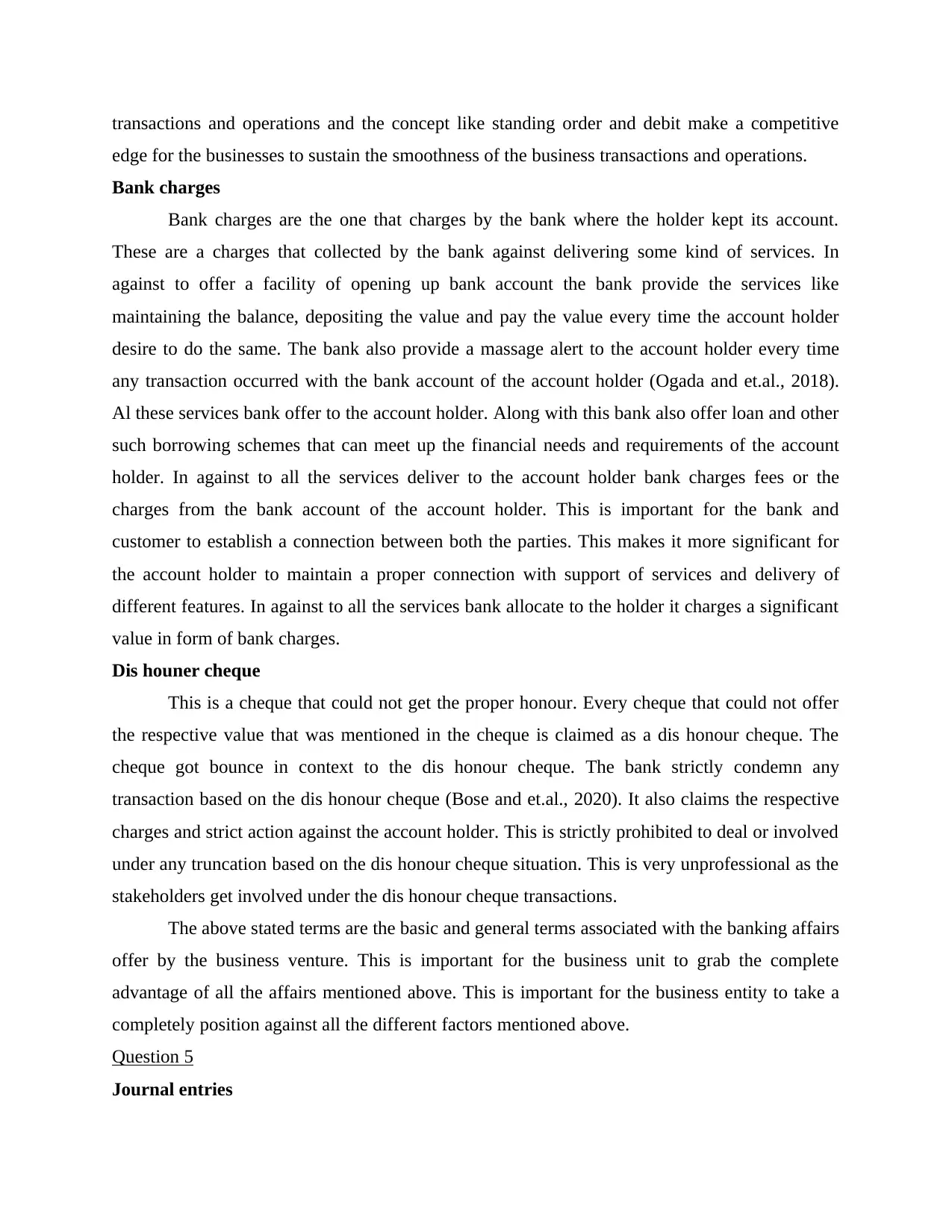
transactions and operations and the concept like standing order and debit make a competitive
edge for the businesses to sustain the smoothness of the business transactions and operations.
Bank charges
Bank charges are the one that charges by the bank where the holder kept its account.
These are a charges that collected by the bank against delivering some kind of services. In
against to offer a facility of opening up bank account the bank provide the services like
maintaining the balance, depositing the value and pay the value every time the account holder
desire to do the same. The bank also provide a massage alert to the account holder every time
any transaction occurred with the bank account of the account holder (Ogada and et.al., 2018).
Al these services bank offer to the account holder. Along with this bank also offer loan and other
such borrowing schemes that can meet up the financial needs and requirements of the account
holder. In against to all the services deliver to the account holder bank charges fees or the
charges from the bank account of the account holder. This is important for the bank and
customer to establish a connection between both the parties. This makes it more significant for
the account holder to maintain a proper connection with support of services and delivery of
different features. In against to all the services bank allocate to the holder it charges a significant
value in form of bank charges.
Dis houner cheque
This is a cheque that could not get the proper honour. Every cheque that could not offer
the respective value that was mentioned in the cheque is claimed as a dis honour cheque. The
cheque got bounce in context to the dis honour cheque. The bank strictly condemn any
transaction based on the dis honour cheque (Bose and et.al., 2020). It also claims the respective
charges and strict action against the account holder. This is strictly prohibited to deal or involved
under any truncation based on the dis honour cheque situation. This is very unprofessional as the
stakeholders get involved under the dis honour cheque transactions.
The above stated terms are the basic and general terms associated with the banking affairs
offer by the business venture. This is important for the business unit to grab the complete
advantage of all the affairs mentioned above. This is important for the business entity to take a
completely position against all the different factors mentioned above.
Question 5
Journal entries
edge for the businesses to sustain the smoothness of the business transactions and operations.
Bank charges
Bank charges are the one that charges by the bank where the holder kept its account.
These are a charges that collected by the bank against delivering some kind of services. In
against to offer a facility of opening up bank account the bank provide the services like
maintaining the balance, depositing the value and pay the value every time the account holder
desire to do the same. The bank also provide a massage alert to the account holder every time
any transaction occurred with the bank account of the account holder (Ogada and et.al., 2018).
Al these services bank offer to the account holder. Along with this bank also offer loan and other
such borrowing schemes that can meet up the financial needs and requirements of the account
holder. In against to all the services deliver to the account holder bank charges fees or the
charges from the bank account of the account holder. This is important for the bank and
customer to establish a connection between both the parties. This makes it more significant for
the account holder to maintain a proper connection with support of services and delivery of
different features. In against to all the services bank allocate to the holder it charges a significant
value in form of bank charges.
Dis houner cheque
This is a cheque that could not get the proper honour. Every cheque that could not offer
the respective value that was mentioned in the cheque is claimed as a dis honour cheque. The
cheque got bounce in context to the dis honour cheque. The bank strictly condemn any
transaction based on the dis honour cheque (Bose and et.al., 2020). It also claims the respective
charges and strict action against the account holder. This is strictly prohibited to deal or involved
under any truncation based on the dis honour cheque situation. This is very unprofessional as the
stakeholders get involved under the dis honour cheque transactions.
The above stated terms are the basic and general terms associated with the banking affairs
offer by the business venture. This is important for the business unit to grab the complete
advantage of all the affairs mentioned above. This is important for the business entity to take a
completely position against all the different factors mentioned above.
Question 5
Journal entries
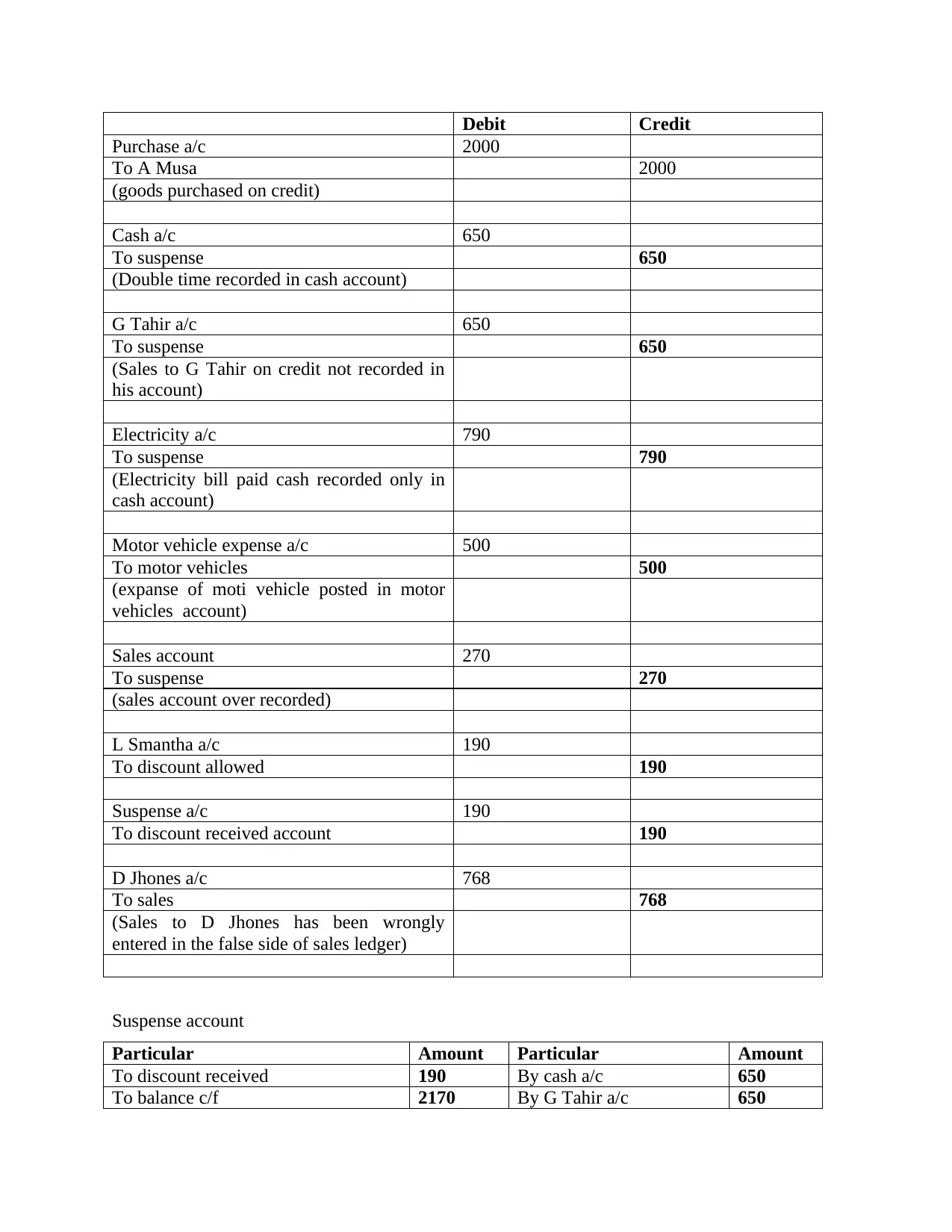
Debit Credit
Purchase a/c 2000
To A Musa 2000
(goods purchased on credit)
Cash a/c 650
To suspense 650
(Double time recorded in cash account)
G Tahir a/c 650
To suspense 650
(Sales to G Tahir on credit not recorded in
his account)
Electricity a/c 790
To suspense 790
(Electricity bill paid cash recorded only in
cash account)
Motor vehicle expense a/c 500
To motor vehicles 500
(expanse of moti vehicle posted in motor
vehicles account)
Sales account 270
To suspense 270
(sales account over recorded)
L Smantha a/c 190
To discount allowed 190
Suspense a/c 190
To discount received account 190
D Jhones a/c 768
To sales 768
(Sales to D Jhones has been wrongly
entered in the false side of sales ledger)
Suspense account
Particular Amount Particular Amount
To discount received 190 By cash a/c 650
To balance c/f 2170 By G Tahir a/c 650
Purchase a/c 2000
To A Musa 2000
(goods purchased on credit)
Cash a/c 650
To suspense 650
(Double time recorded in cash account)
G Tahir a/c 650
To suspense 650
(Sales to G Tahir on credit not recorded in
his account)
Electricity a/c 790
To suspense 790
(Electricity bill paid cash recorded only in
cash account)
Motor vehicle expense a/c 500
To motor vehicles 500
(expanse of moti vehicle posted in motor
vehicles account)
Sales account 270
To suspense 270
(sales account over recorded)
L Smantha a/c 190
To discount allowed 190
Suspense a/c 190
To discount received account 190
D Jhones a/c 768
To sales 768
(Sales to D Jhones has been wrongly
entered in the false side of sales ledger)
Suspense account
Particular Amount Particular Amount
To discount received 190 By cash a/c 650
To balance c/f 2170 By G Tahir a/c 650

By electricity account 790
By sales account 270
2360 2360
By sales account 270
2360 2360
Secure Best Marks with AI Grader
Need help grading? Try our AI Grader for instant feedback on your assignments.

REFERENCES
Books and journals
Ahmed, I., 2019. Bridging the gap between governmental accounting education and
practice. Accounting. 5(1). pp.21-30.
Aqeel, S.M., Aws, S.M. and Nawfal, H.A., 2020. The role of real time reporting to limiting the
creative accounting practice. Вопросы инновационной экономики. 10(4). pp.2347-
2358.
Beretta, E. and Cencini, A., 2020. Double-entry bookkeeping and balance of payments: the need
for developing a new approach. Insights into Regional Development. 2(3). pp.610-629.
Bradford, B., 2020. Fundamental Principles of Accounting: A Case Analysis.
Comandaru, and et.al., 2020. ACCOUNTING INFORMATION-NOTICE OF AN EFFICIENT
DECISION SYSTEM. Hyperion Economic Journal, p.3.
Gheorghe, H., 2017. Preliminary Accounting Works For The Establishment Of Financial
Statements. Annals-Economy Series. 1. pp.158-165.
Gheorghe, H., 2017. Preliminary Accounting Works For The Establishment Of Financial
Statements. Annals-Economy Series. 1. pp.158-165.
Guliyev, V. and Hajiyev, N., 2020. POSTULATES AND PRINCIPLES IN
ACCOUNTING. Economic and Social Development: Book of Proceedings. 2. pp.674-
683.
Gurskaya, M., Kuter, M. and Bagdasaryan, R., 2019, May. The structure of the trial balance.
In International Conference on Integrated Science (pp. 103-116). Springer, Cham.
Iyer, and et.al., 2019, April. Bank Reconciliation Bot. In 2nd International Conference on
Advances in Science & Technology (ICAST).
Khansalar, E. and Namazi, M., 2017. Cash flow disaggregation and prediction of cash
flow. Journal of Applied Accounting Research.
Kumar, V., 2020. Accounting Principles.
Lokanan, M., Tran, V. and Vuong, N.H., 2019. Detecting anomalies in financial statements using
machine learning algorithm. Asian Journal of Accounting Research.
Ofori-Atta, K., Bruce-Twum, E. and Appiah-Gyamerah, I., 2017. Fundamentals of financial
Accounting 11.
Omoolorun, A.J. and Abilogun, T.O., 2017. Fraud free financial report: A conceptual
review. International Journal of Academic Research in Accounting, Finance and
Management Sciences. 7(4). pp.83-94.
Shaw, J.J.W.K.W., 2021. Fundamental Accounting Principles.
TEX, S., 2019. Financial Express.
O’Neal, M. and O'Neal, M., 2018. ENGLISH-GERMAN TERMINOLOGY. In Banking and
financial English (pp. 163-170). Oldenbourg Wissenschaftsverlag.
Rafati, L. and Derde, P., 2017. BOEM: Business Object oriented Enterprise Modeling. In PoEM
Doctoral Consortium (pp. 41-49).
Ogada, M. J. and et.al., 2018. The burden of produce cess and other market charges in Kenya’s
agriculture. African Journal of Economic Review. 6(2). pp.232-245.
Books and journals
Ahmed, I., 2019. Bridging the gap between governmental accounting education and
practice. Accounting. 5(1). pp.21-30.
Aqeel, S.M., Aws, S.M. and Nawfal, H.A., 2020. The role of real time reporting to limiting the
creative accounting practice. Вопросы инновационной экономики. 10(4). pp.2347-
2358.
Beretta, E. and Cencini, A., 2020. Double-entry bookkeeping and balance of payments: the need
for developing a new approach. Insights into Regional Development. 2(3). pp.610-629.
Bradford, B., 2020. Fundamental Principles of Accounting: A Case Analysis.
Comandaru, and et.al., 2020. ACCOUNTING INFORMATION-NOTICE OF AN EFFICIENT
DECISION SYSTEM. Hyperion Economic Journal, p.3.
Gheorghe, H., 2017. Preliminary Accounting Works For The Establishment Of Financial
Statements. Annals-Economy Series. 1. pp.158-165.
Gheorghe, H., 2017. Preliminary Accounting Works For The Establishment Of Financial
Statements. Annals-Economy Series. 1. pp.158-165.
Guliyev, V. and Hajiyev, N., 2020. POSTULATES AND PRINCIPLES IN
ACCOUNTING. Economic and Social Development: Book of Proceedings. 2. pp.674-
683.
Gurskaya, M., Kuter, M. and Bagdasaryan, R., 2019, May. The structure of the trial balance.
In International Conference on Integrated Science (pp. 103-116). Springer, Cham.
Iyer, and et.al., 2019, April. Bank Reconciliation Bot. In 2nd International Conference on
Advances in Science & Technology (ICAST).
Khansalar, E. and Namazi, M., 2017. Cash flow disaggregation and prediction of cash
flow. Journal of Applied Accounting Research.
Kumar, V., 2020. Accounting Principles.
Lokanan, M., Tran, V. and Vuong, N.H., 2019. Detecting anomalies in financial statements using
machine learning algorithm. Asian Journal of Accounting Research.
Ofori-Atta, K., Bruce-Twum, E. and Appiah-Gyamerah, I., 2017. Fundamentals of financial
Accounting 11.
Omoolorun, A.J. and Abilogun, T.O., 2017. Fraud free financial report: A conceptual
review. International Journal of Academic Research in Accounting, Finance and
Management Sciences. 7(4). pp.83-94.
Shaw, J.J.W.K.W., 2021. Fundamental Accounting Principles.
TEX, S., 2019. Financial Express.
O’Neal, M. and O'Neal, M., 2018. ENGLISH-GERMAN TERMINOLOGY. In Banking and
financial English (pp. 163-170). Oldenbourg Wissenschaftsverlag.
Rafati, L. and Derde, P., 2017. BOEM: Business Object oriented Enterprise Modeling. In PoEM
Doctoral Consortium (pp. 41-49).
Ogada, M. J. and et.al., 2018. The burden of produce cess and other market charges in Kenya’s
agriculture. African Journal of Economic Review. 6(2). pp.232-245.

Bose, A. and et.al., 2020. Law of Contract-II-Fall 2020.
Online references
Basic accounting principles., 2021. [Online]. Available through
<https://www.accountingtools.com/articles/2017/5/15/basic-accounting-principles>
2
Online references
Basic accounting principles., 2021. [Online]. Available through
<https://www.accountingtools.com/articles/2017/5/15/basic-accounting-principles>
2

3
1 out of 25
Related Documents
Your All-in-One AI-Powered Toolkit for Academic Success.
+13062052269
info@desklib.com
Available 24*7 on WhatsApp / Email
![[object Object]](/_next/static/media/star-bottom.7253800d.svg)
Unlock your academic potential
© 2024 | Zucol Services PVT LTD | All rights reserved.





